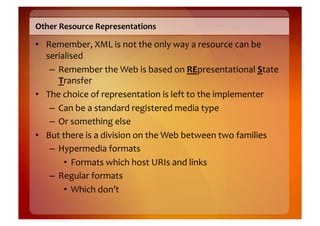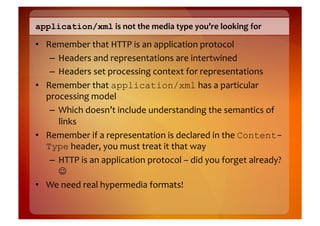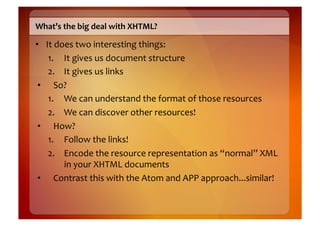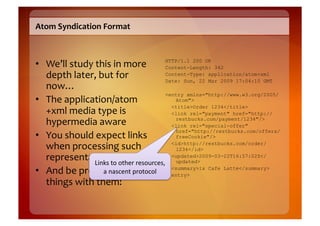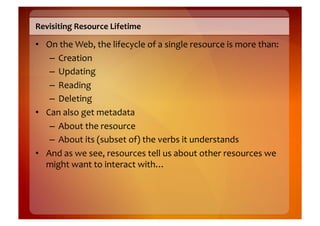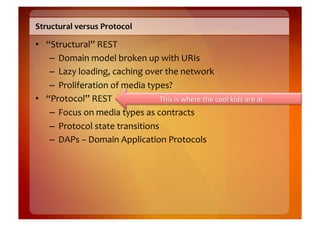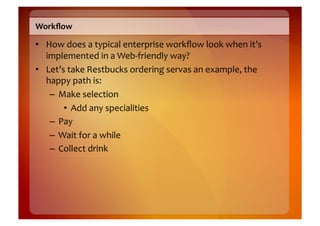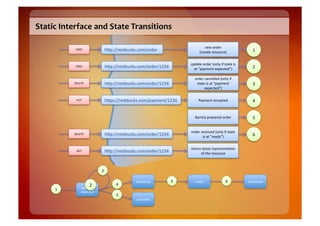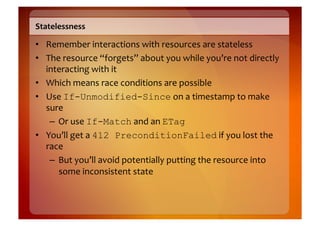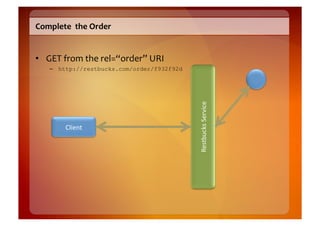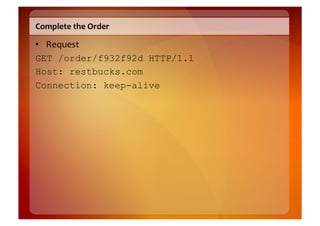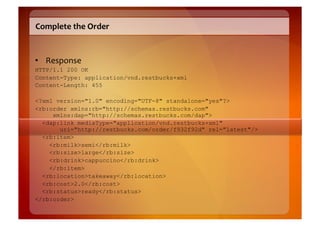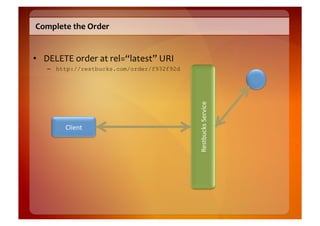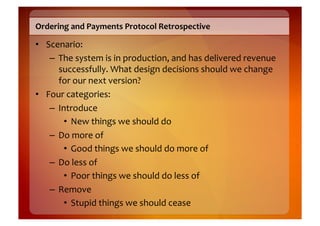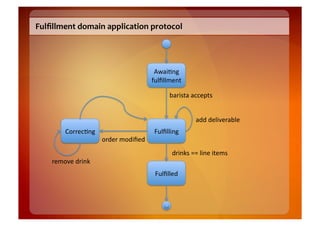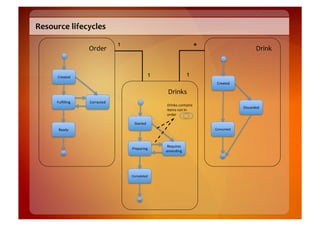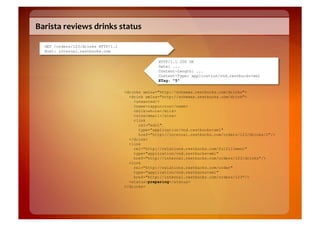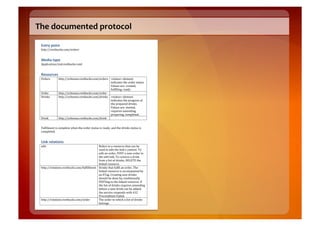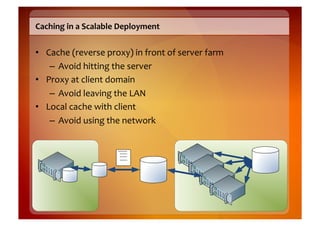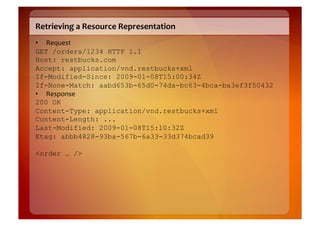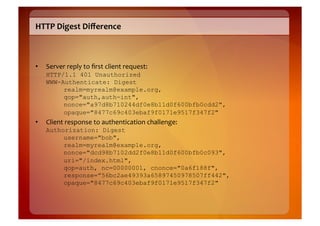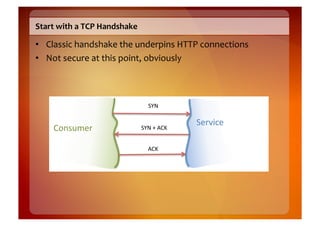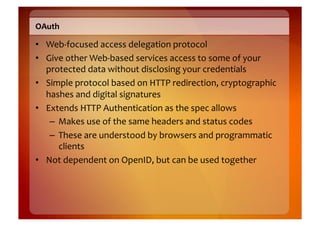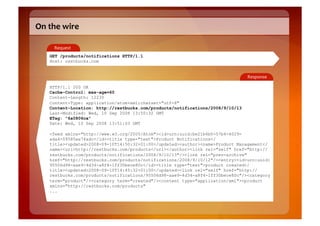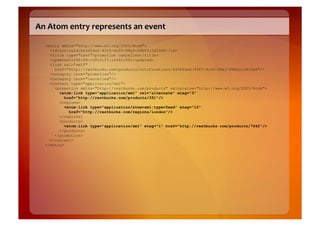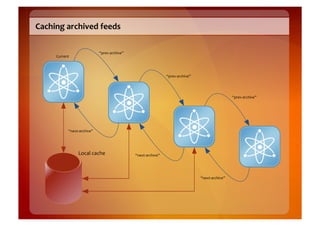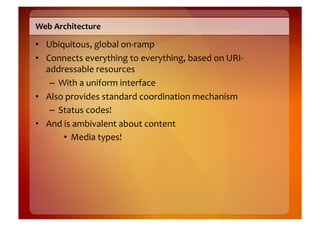REST in Practice
- 1. REST in Practice A Tutorial on Web-‐based Services Jim Webber h*p://jim.webber.name Savas Parasta8dis h*p://savas.me Ian Robinson h*p://iansrobinson.com
- 2. Motivation • This follows the plot from a book called REST in Practice which is currently being written by: – Jim Webber – Savas Parastatidis – Ian Robinson • With help from lots of other lovely people like: – Halvard Skogsrud, Lasse Westh-‐Nielsen, Steve Vinoski, Mark Nottingham, Colin Jack, Spiros Tzavellas, Glen Ford, Sriram Narayan, Ken Kolchier, Guilherme Silveira and many more! • The book deals with the Web as a distributed computing platform – The Web as a whole, not just REST • And so does this tutorial…
- 3. Timetable • 09:00-‐10:30 • 12:00-‐13:00 – Web basics – Lunch – URI templates – RPC • 13:00-‐14:30 – HTTP – Hypermedia design – CRUD – Scalability • 10:30-‐10:45 – Security – Coffee break • 14:30-‐14:45 • 10:45-‐12:00 – Coffee break – Semantics • 14:45-‐16:00 – Hypermedia formats – Atom – Restbucks DAP – AtomPub – Restbucks retrospective – Epilogue
- 4. Introduction • This is a tutorial about the Web • It’s very HTTP centric • But it’s not about Web pages! • The Web is a middleware platform which is… – Globally deployed – Has reach – Is mature – And is a reality in every part of our lives • Which makes it interesting for distributed systems geeks
- 5. Leonard Richardson's Web service maturity heuristic What? Why? How? Spreads complexity URIs Divide and conquer around Refactor (Do the same things Reduces complexity Uniform interface in the same way) Describe special Makes complexity Hypermedia behaviour in a learnable standard way http://www.crummy.com/writing/
- 6. Why Web? Why not just REST? • REST is a brilliant architectural style • But the Web allows for more than just RESTful systems • There’s a spectrum of maturity of service styles – From completely bonkers to completely RESTful • We’ll use the Richardson maturity model to frame these kinds of discussions – Level 0 to Level 3 – Web-‐ignorant to RESTful!
- 7. HTTP URIs REST is an Architectural style suited to the Web… …but it is not mandatory
- 8. Why the Web? Why be RESTful? • Scalable • Fault-‐tolerant • Recoverable • Secure • Loosely coupled • Precisely the same characteristics we want in business software systems!
- 9. REST isn’t… • Just pretty URIs • Just XML or JSON • URI templates • AJAX applications But you could be forgiven for thinking it is!
- 10. Web Architecture
- 11. Web History • Started as a distributed hypermedia platform – CERN, Berners-‐Lee, 1990 • Revolutionised hypermedia – Imagine emailing someone a hypermedia deck nowadays! • Architecture of the Web largely fortuitous – W3C and others have since retrofitted/captured the Web’s architectural characteristics
- 12. The Web broke the rules
- 13. Web Fundamentals • To embrace the Web, we need to understand how it works • The Web is a distributed hypermedia model – It doesn’t try to hide that distribution from you! • Our challenge: – Figure out the mapping between our problem domain and the underlying Web platform
- 14. Key Actors in the Web Architecture Client Cache Firewall Firewall Resources Router Web Server Web Server ISP Reverse Proxy Proxy Server Firewall Resources
- 15. Resources • A resource is something “interesting” in your system • Can be anything – Spreadsheet (or one of its cells) – Blog posting – Printer – Winning lottery numbers – A transaction – Others?
- 16. Interacting with Resources • We deal with representations of resources – Not the resources themselves • “Pass-‐by-‐value” semantics – Representation can be in any format • Any media type • Each resource implements a standard uniform interface – Typically the HTTP interface • Resources have names and addresses (URIs) – Typically HTTP URIs (aka URLs)
- 17. Resource Architecture Consumer (Web Client) Uniform Interface (Web Server) Logical Resources Resource Representa8on (e.g. XML document) Physical Resources
- 18. Resource Representations • Making your system Web-‐friendly increases its surface area – You expose many resources, rather than fewer endpoints • Each resource has one or more representations – Representations like JSON or XML or good for the programmatic Web • Moving representations across the network is the way we transact work in a Web-‐native system
- 19. URIs • URIs are addresses of resources in Web-‐based systems – Each resource has at least one URI • They identify “interesting” things – i.e. Resources • Any resource implements the same (uniform) interface – Which means we can access it programmatically! • Declarative scheme
- 20. URI/Resource Relationship • Any two resources cannot be identical – Because then you’ve only got one resource! • But they can have more than one name – http://foo.com/software/latest – http://foo.com/software/v1.4 • No mechanism for URI equality • Canonical URIs are long-‐lived – E.g. http://example.com/versions/1.1 versus http://example.com/versions/latest – Send back HTTP 303 (“see also”) if the request is for an alternate URI – Or set the Content-‐Location header in the response
- 21. Scalability • Web is truly Internet-‐scale – Loose coupling • Growth of the Web in one place is not impacted by changes in other places – Uniform interface • HTTP defines a standard interface for all actors on the Web • Replication and caching is baked into this model – Caches have the same interface as real resources! – Stateless model • Supports horizontal scaling
- 22. Fault Tolerant • The Web is stateless – All information required to process a request must be present in that request • Sessions are still plausible, but must be handled in a Web-‐consistent manner – Modelled as resources! • Statelessness means easy replication – One Web server is replaceable with another – Easy fail-‐over, horizontal scaling
- 23. Recoverable • The Web places emphasis on repeatable information retrieval – GET is idempotent • Library of Congress found this the hard way! – In failure cases, can safely repeat GET on resources • HTTP verbs plus rich error handling help to remove guesswork from recovery – HTTP statuses tell you what happened! – Some verbs (e.g. PUT, DELETE) are safe to repeat
- 24. Secure • HTTPs is a mature technology – Based on SSL for secure point-‐to-‐point information retrieval • Isn’t sympathetic to Web architecture – Restricted caching opportunities • Higher-‐order protocols like Atom are starting to change this... – Encrypt parts of a resource representation, not the transport channel – OK to cache!
- 25. Loosely Coupled • Adding a Web site to the WWW does not affect any other existing sites • All Web actors support the same, uniform interface – Easy to plumb new actors into the big wide web • Caches, proxies, servers, resources, etc
- 26. Tech Interlude URI Templates
- 27. Conflicting URI Philosophies • URIs should be descriptive, predictable? – http://spreadsheet/cells/a2,a9 – http://jim.webber.name/2007/06.aspx • Convey some ideas about how the underlying resources are arranged – Can infer http://spreadsheet/cells/b0,b10 and http:// jim.webber.name/2005/05.aspx for example • Nice for programmatic access, but may introduce coupling • URIs should be opaque? – http://tinyurl.com/6 – TimBL says “opaque URIs are cool” • Convey no semantics, can’t infer anything from them – Don’t introduce coupling
- 28. URI Templates, in brief • Use URI templates to make your resource structure easy to understand • For Amazon S3 (storage service) it’s easy: – http://s3.amazon.com/{bucket-name}/{object- name} Bucket1 Bucket2 Object2 Object1 Object1 Object3 Object2
- 29. URI Templates are Easy! • Take the URI: http://restbucks.com/orders?{order_id} • You could do the substitution and get a URI: http://restbucks.com/orders?1234 • Can easily make more complex URIs too – Mixing template and non-‐template sections http://restbucks.com/{orders}/{shop}/{year}/{month}.xml • Use URI templates client-‐side to compute server-‐side URIs – But beware this introduces coupling!
- 30. Why URI Templates? • Regular URIs are a good idiom in Web-‐based services – Helps with understanding, self documentation • They allow users to infer a URI – If the pattern is regular • URI templates formalise this arrangement – And advertise a template rather than a regular URI
- 31. URI Templates Pros and Cons • Everything interesting in a Web-‐based service has a URI • Remember, two schools of thought: – Opaque URIs are cool (Berners-‐Lee) – Transparent URIs are cool (everyone else) • URI templates present two core concerns: – They invite clients to invent URIs which may not be honoured by the server – They increase coupling since servers must honour forever any URI templates they’ve advertised • Use URI templates sparingly, and with caution – Entry point URIs only is a good rule of thumb
- 32. RPC Again!
- 33. Web Tunnelling • Web Services tunnel SOAP over HTTP – Using the Web as a transport only – Ignoring many of the features for robustness the Web has built in • Many Web people do the same! – URI tunnelling, POX approaches are the most popular styles on today’s Web – Worse than SOAP! But they claim to be “lightweight” • Less metadata! and RESTful
- 34. Richardson Model Level 1 • Lots of URIs – But really has a more level 0 mindset • Doesn’t understand HTTP – Other than as a transport • No hypermedia
- 35. URI Tunnelling Pattern • Web servers understand URIs • URIs have structure • Methods have signatures • Can match URI structure to method signature
- 36. On The Wire
- 37. Server-‐Side URI Tunnelling Example public void ProcessGet(HttpListenerContext context) { // Parse the URI Order order = ParseUriForOrderDetails(context.Request.QueryString); string response = string.Empty; if (order != null) { // Process the order by calling the mapped method var orderConfirmation = RestbucksService.PlaceOrder(order); response = "OrderId=" + orderConfirmation.OrderId.ToString(); } else { response = "Failure: Could not place order."; } // Write to the response stream using (var sw = new StreamWriter(context.Response.OutputStream)) { sw.Write(response); } }
- 38. Client-‐Side URI Tunnelling public OrderConfirmation PlaceOrder(Order order) { // Create the URI var sb = new StringBuilder("http://restbucks.com/PlaceOrder?"); sb.AppendFormat("coffee={0}", order.Coffee.ToString()); sb.AppendFormat("&size={0}", order.Size.ToString()); sb.AppendFormat("&milk={0}", order.Milk.ToString()); sb.AppendFormat("&consume-location={0}", order.ConsumeLocation.ToString()); // Set up the GET request var request = HttpRequest.Create(sb.ToString()) as HttpWebRequest; request.Method = "GET"; // Get the response var response = request.GetResponse(); // Read the contents of the response OrderConfirmation orderConfirmation = null; using (var sr = new StreamReader(response.GetResponseStream())) { var str = sr.ReadToEnd(); // Create an OrderConfirmation object from the response orderConfirmation = new OrderConfirmation(str); } return orderConfirmation; }
- 39. URI Tunnelling Strengths • Very easy to understand • Great for simple procedure-‐calls • Simple to code – Do it with the servlet API, HttpListener, IHttpHandler, Rails, whatever! • Interoperable – It’s just URIs!
- 40. URI Tunnelling Weaknesses • It’s brittle RPC! • Tight coupling, no metadata – No typing or “return values” specified in the URI • Not robust – have to handle failure cases manually • No metadata support – Construct the URIs yourself, map them to the function manually • You typically use GET (prefer POST) – OK for functions, but against the Web for procedures with side-‐affects
- 41. POX Pattern • Web servers understand how to process requests with bodies – Because they understand forms • And how to respond with a body – Because that’s how the Web works • POX uses XML in the HTTP request and response to move a call stack between client and server
- 42. Richardson Model Level 0 • Single well-‐known endpoint – Not really URI friendly • Doesn’t understand HTTP – Other than as a transport • No hypermedia
- 43. POX Architecture
- 44. POX on the Wire
- 45. .Net POX Service Example From the Web server private void ProcessRequest(HttpListenerContext context) { string verb = context.Request.HttpMethod.ToLower().Trim(); switch (verb) { case "post": Check HTTP Verb (we { want POST) // Everything's done with post in this case XmlDocument request = new XmlDocument(); request.Load(XmlReader.Create (context.Request.InputStream)); Dispatch it for processing Turn the HTTP body into an XmlElement result = MyApp.Processdocument for XML (request.DocumentElement); processing byte[] returnValue = Utils.ConvertUnicodeString (Constants.Xml.XML_DECLARATION + result.OuterXml); Get XML result, and get bytes context.Response.OutputStream.Write(returnValue, 0, returnValue.Length); break; } ... Return XML bytes to client
- 46. Java POX Servlet public class RestbucksService extends HttpServlet { @Override protected void doPost(HttpServletRequest request, HttpServletResponse response) throws ServletException, IOException { // Initialization code omitted for brevity try { requestReader = request.getReader(); responseWriter = response.getWriter(); String xmlRequest = extractPayload(requestReader); Order order = createOrder(xmlRequest); OrderConfirmation confirmation = restbucksService.placeOrder(order); embedPayload(requestWriter, confirmation.toString()); } finally { // Cleanup code omitted for brevity } }
- 47. C# POX Client Example public OrderConfirmation PlaceOrder(string customerId, Item[] items) { // Serialize our objects XmlDocument requestXml = CreateXmlRequest(customerId, items); var client = new WebClient(); var ms = new MemoryStream(); requestXml.Save(ms); client.Headers.Add("Content-Type", "application/xml"); ms = new MemoryStream(client.UploadData("http://restbucks.com/ PlaceOrder", null, ms.ToArray())); var responseXml = new XmlDocument(); responseXml.Load(ms); return CreateOrderConfirmation(responseXml); }
- 48. Java Apache Commons Client public class OrderingClient { private String sendRequestPost(String request, String uri) private static final String XML_HEADING = "<?xml throws version="1.0"?>n"; IOException, HttpException { private static final String NO_RESPONSE = "Error: No response."; PostMethod method = new PostMethod (uri); public String placeOrder(String customerId, method.setRequestHeader("Content- String[] itemIds) type", "application/xml"); throws Exception { method.setRequestBody(XML_HEADING + request); // XML string creation omitted for brevity // ... String responseBody = NO_RESPONSE; try { String response = sendRequestPost(request, new HttpClient().executeMethod "http://restbucks.com/PlaceOrder"); (method); responseBody = new String Document xmlResponse = (method.getResponseBody(), "UTF-8"); DocumentBuilderFactory.newInstance() .newDocumentBuilder } finally { ().parse( method.releaseConnection(); new InputSource(new } StringReader(response))); return responseBody; // XML response handling omitted for brevity } } }
- 49. POX Strengths • Simplicity – just use HTTP POST and XML • Re-‐use existing infrastructure and libraries • Interoperable – It’s just XML and HTTP • Can use complex data structures – By encoding them in XML
- 50. POX Weaknesses • Client and server must collude on XML payload – Tightly coupled approach • No metadata support – Unless you’re using a POX toolkit that supports WSDL with HTTP binding (like WCF) • Does not use Web for robustness • Does not use SOAP + WS-‐* for robustness either
- 51. Web Abuse • Both POX and URI Tunnelling fail to take advantage of the Web – Ignoring status codes – Reduced scope for caching – No metadata – Manual crash recovery/compensation leading to high development cost – Etc • They’re useful in some situations – And you can implement them with minimal toolkit support – But they’re not especially robust patterns
- 53. Tech Interlude HTTP Fundamentals
- 54. The HTTP Verbs Decreasing likelihood of being understood by a • Retrieve a representation of a resource: GET • Create a new resource: PUT to a new URI, or POST to an existing URI Web server today • Modify an existing resource: PUT to an existing URI • Delete an existing resource: DELETE • Get metadata about an existing resource: HEAD • See which of the verbs the resource understands: OPTIONS
- 55. HEAD Semantics • HEAD is like GET, except it only retrieves metadata • Request HEAD /order/1234 HTTP 1.1 Host: restbucks.com • Response 200 OK Content-Type: application/vnd.restbucks +xml Last-Modified: 2007-07-08T15:00:34Z Etag: aabd653b-65d0-74da-bc63-4bca- ba3ef3f50432 Useful for caching, performance
- 56. OPTIONS Semantics • Asks which methods are supported by a resource – Easy to spot read-‐only resources for example • Request OPTIONS /orders/1234 HTTP 1.1 Host: restbucks.com • Response You can only read and add to this resource, may change 200 OK over 8me Allow: GET,HEAD,POST
- 57. HTTP Status Codes • The HTTP status codes provide metadata about the state of resources • They are part of what makes the Web a rich platform for building distributed systems • They cover five broad categories – 1xx -‐ Metadata – 2xx – Everything’s fine – 3xx – Redirection – 4xx – Client did something wrong – 5xx – Server did a bad thing • There are a handful of these codes that we need to know in more detail
- 58. 1xx • 100 – Continue – The operation will be accepted by the service – The “look before you leap” pattern • Use with the Expect header • Request POST /orders HTTP/1.1 Content-Type: application/xml Expect: 100-continue • Response 100 Continue or 417 Expectation Failed
- 59. 2xx • 200 – OK – The server successfully completed whatever the client asked of it • 201 – Created – Sent when a new resource is created at the client’s request via POST – Location header should contain the URI to the newly created resource • 202 – Accepted – Client’s request can’t be handled in a timely manner – Location header should contain a URI to the resource that will eventually be exposed to fulfil the client’s expectations
- 60. More 2xx Codes • 203 – Non-‐Authoritative Information – Much like 200, except the client knows not to place full trust in any headers since they could have come from 3rd parties or be cached etc. • 204 – No Content – The server declines to send back a representation • Perhaps because the associated resource doesn’t have one – Used like an “ack” • Prominent in AJAX applications • 206 – Partial Content – Optimisation used in failure cases to support partial GETs – Request Content-Range header must specify the byte range of the resource representation it wants – Response headers must contain Date; • ETag and Content-Location headers must be consistent with the original request not the current values
- 61. 3xx • 301 – Multiple Choices – Response Location header should contain the preferred URI – Message body can contain list of URIs • In XHTML possibly – In general avoid being ambiguous! • 301 – Moved Permanently – Location header contains the new location of the resource • 303 – See Other – Location header contains the location of an alternative resource – Used for redirection
- 62. More 3xx • 304 – Not Modified – The resource hasn’t changed, use the existing representation – Used in conjunction with conditional GET – Client sends the If-Modified-Since header – Response Date header must be set – Response Etag and Content-Location headers must be same as original representation • 307 – Temporary Redirect – The request hasn’t been processed, because the resource has moved – Client must resubmit request to the URI in the response Location header
- 63. 4xx • 400 – Bad Request – The client has PUT or POST a resource representation that is in the right format, but contains invalid information • 401 – Unauthorized – Proper credentials to operate on a resource weren’t provided – Response WWW-Authenticate header contains the type of authentication the server expects • Basic, digest, WSSE, etc – Don’t leak information! • Consider 404 in these situations
- 64. More 4xx • 403 – Forbidden – The client request is OK, but the server doesn’t want to process it • E.g. Restricted by IP address – Implies that resource exists, beware leaking information • 404 – Not Found – The standard catch-‐all response – May be a lie to prevent 401 or 403 information leakage
- 65. Even more 4xx • 405 – Method Not Allowed – The resource doesn’t support a given method – The response Allow header lists the verbs the resource understands • E.g. Allow: GET, POST, PUT • 406 – Not Acceptable – The client places too many restrictions on the resource representation via the Accept-* header in the request – The server can’t satisfy any of those representations
- 66. Yet More 4xx • 409 – Conflict – Tried to change the state of the resource to something the server won’t allow • E.g. Trying to DELETE something that doesn’t exist • 410 – Gone – The resource has gone, permanently. – Don’t send in response to DELETE • The client won’t know if it was deleted, or if it was gone and the delete failed • 411 – Length Required – If a request (POST, PUT) contains a representation, it should set the Content-Length header – The server might demand this, and interrupt the client request
- 67. Still more 4xx • 412 – Precondition Failed – Server/resource couldn’t meet one or more preconditions • As specified in the request header – E.g. Using If-Unmodified-Since and PUT to modify a resource provided it hasn’t been changed by others • 413 – Request Entity Too Large – Response comes with the Retry-After header in the hope that the failure is transient
- 68. Final 4xx Codes • 414 – Request URI Too Long – You’ve got a hopeless HTTP server, or ridiculous URI names! • 415 Unsupported Media Type – E.g. If the server resource expects JSON but the client sends XML
- 69. 5xx Codes • 500 – Internal Server Error – The normal response when we’re lazy • 501 – Not Implemented – The client tried to use something in HTTP which this server doesn’t support • Keep HTTP use simple, get a better HTTP server • 502 – Bad Gateway – A proxy failed – Doesn’t help us much
- 70. More 5xx Codes • 503 – Service Unavailable – The HTTP server is up, but not supporting resource communication properly – Server may send a Retry-After header, assuming the fault is transient
- 71. HTTP Headers • Headers provide metadata to assist processing – Identify resource representation format (media type), length of payload, supported verbs, etc • HTTP defines a wealth of these – And like status codes they are our building blocks for robust service implementations
- 72. Must-‐know Headers • Authorization – Contains credentials (basic, digest, WSSE, etc) – Extensible • Content-‐Length – Length of payload, in bytes • Content-‐Type – The resource representation form • E.g. application/vnd.restbucks+xml, application/ xhtml+xml
- 73. More Must-‐Know Headers • Etag/If-‐None-‐Match – Opaque identifier – think “checksum” for resource representations – Used for conditional GET • If-‐Modified-‐Since/Last-‐Modified – Used for conditional GET too • Host – Contains the domain-‐name part of the URI
- 74. Yet More Must-‐Know Headers • Location – Used to flag the location of a created/moved resource – In combination with: • 201 Created, 301 Moved Permanently, 302 Found, 307 Temporary Redirect, 300 Multiple Choices, 303 See Other • User-‐Agent – Tells the server side what the client-‐side capabilities are – Should not be used in the programmable Web!
- 75. Final Must-‐Know Headers • WWW-‐Authenticate – Used with 401 status – Informs client what authentication is needed • Date – Mandatory! – Timestamps on request and response
- 76. Useful Headers • Accept – Client tells server what formats it wants – Can externalise this in URI names in the general case • Accept-‐Encoding – Client tells server that it can compress data to save bandwidth – Client specifies the compression algorithm it understands • Content-‐Encoding – Server-‐side partner of Accept-‐Encoding
- 77. More Useful Headers • Allow – Server tells client what verbs are allowed for the requested resource (used in combination with OPTIONS) • Cache-‐Control – Metadata for caches, tells them how to cache (or not) the resource representation – And for how long etc. • Content-‐MD5 – Cryptographic checksum of body – Useful integrity check, has computation cost
- 78. Yet More Useful Headers • Expect – A conditional – client asks if it’s OK to proceed by expecting 100-‐Continue – Server either responds with 100 or 417 – Expectation Failed • Expires – Server tells client or proxy server that representation can be safely cached until a certain time • If-‐Match – Used for ETag comparison – Opposite of If-‐None-‐Match
- 79. Final Useful Headers • If-‐Unmodified-‐Since – Useful for conditional PUT/POST • Make sure the resource hasn’t changed while you’re been manipulating it – Compare with If-‐Modified-‐Since • Range – Specify part of a resource representation (a byte range) that you need – aka partial GET – Useful for failure/recovery scenarios
- 80. Less Often-‐Used Headers • Retry-‐After – Resource or server is out of action for the specified time – Usually associated with 413 – Request Entity Too Large, or one of the 5xx server error statuses • Content-‐Location – Header gives the canonical URI of the resource – Client might be using a different URI to access that resource
- 81. HTTP RCF 2616 is Authoritative • The statuses and headers here are a sample of the full range of headers in the HTTP spec • They spec contains more than we discuss here • It is authoritative about usage • And it’s a good thing to keep handy when you’re working on a Web-‐based distributed system!
- 82. Embracing HTTP as an Application Protocol
- 83. Using the Web • URI tunnelling and POX use the Web as a transport – Just like SOAP without metadata support • CRUD services begin to use the Web’s coordination support • But the Web is more than transport HTTP – Transport, plus Headers – Metadata, plus Status Codes – Fault model, plus Uniform Interface – Component model, plus Caches, proxies, servers, etc – Runtime environment, plus...
- 84. CRUD Resource Lifecycle • The resource is created with POST • It’s read with GET • And updated via PUT • Finally it’s removed using DELETE
- 85. Richardson Model Level 2 • Lots of URIs • Understands HTTP! • No hypermedia
- 86. Create with POST POST /orders <order … /> 201 Created Location: …/1234 Ordering Ordering Client 400 Bad Request Service 500 Internal Error
- 87. POST Semantics • POST creates a new resource • But the server decides on that resource’s URI • Common human Web example: posting to Web log – Server decides URI of posting and any comments made on that post • Programmatic Web example: creating a new employee record – And subsequently adding to it
- 88. POST Request POST /orders HTTP/1.1 Verb, path, and HTTP Host: restbucks.example.com version Content-Type:application/vnd.restbucks+xml Restbucks-‐specific XML Content-Length: 225 content <order xmlns="http://schemas.restbucks.com/order"> <location>takeAway</location> Content <items> (again Restbucks XML) <item> <name>latte</name> <quantity>1</quantity> <milk>whole</milk> <size>small</size> </item> </items> </order>
- 89. POST Response HTTP/1.1 201 Created Location: /orders/1234
- 90. When POST goes wrong • We may be 4xx or 5xx errors – Client versus server problem • We turn to GET! • Find out the resource states first – Then figure out how to make forward or backward progress • Then solve the problem – May involve POSTing again – May involve a PUT to rectify server-‐side resources in-‐ place
- 91. POST Implementation with a Servlet protected void doPost(HttpServletRequest request, HttpServletResponse response) { try { Order order = extractOrderFromRequest(request); String internalOrderId = OrderDatabase.getDatabase().saveOrder(order); response.setHeader("Location", computeLocationHeader(request, internalOrderId)); response.setStatus(HttpServletResponse.SC_CREATED); } catch(Exception ex) { response.setStatus(HttpServletResponse.SC_INTERNAL_SERVER_ERROR); } }
- 92. Read with GET GET /orders/1234 200 OK <order … /> Ordering Ordering Client 404 Not Found Service 500 Internal Error
- 93. GET Semantics • GET retrieves the representation of a resource • Should be idempotent – Shared understanding of GET semantics – Don’t violate that understanding! Library of congress catalogue incident!
- 94. GET Exemplified GET /orders/1234 HTTP/1.1 Accept: application/vnd.restbucks+xml Host: restbucks.com
- 95. GET Response HTTP/1.1 200 OK Content-Length: 232 Content-Type: application/vnd.restbucks+xml Date: Wed, 19 Nov 2008 21:48:10 GMT <order xmlns="http://schemas.restbucks.com/order"> <location>takeAway</location> <items> <item> <name>latte</name> <quantity>1</quantity> <milk>whole</milk> <size>small</size> </item> </items> <status>pending</pending> </order>
- 96. When GET Goes wrong • Simple! – Just 404 – the resource is no longer available HTTP/1.1 404 Not Found Content-Type: application/vnd.restbucks+xml Content-Length: 952 Date: Sat, 20 Dec 2008 19:01:33 GMT • Are you sure? – GET again! • GET is safe and idempotent – Great for crash recovery scenarios!
- 97. Idempotent Behaviour • An action with no side affects – Comes from mathematics • In practice means two things: – A safe operation is one which changes no state at all • E.g. HTTP GET – An idempotent operation is one which updates state in an absolute way • E.g. x = 4 rather than x += 2 • Web-‐friendly systems scale because of safety – Caching! • And are fault tolerant because of idempotent behaviour – Just re-‐try in failure cases
- 98. GET JAX-‐RS Implementation @Path("/") public class OrderingService { @GET @Produces("application/xml") @Path("/{orderId}") public String getOrder(@PathParam("orderId") String orderId) { try { Order order = OrderDatabase.getDatabase().getOrder(orderId); if (order != null) { return xstream.toXML(order); } else { throw new WebApplicationException(404); } } catch (Exception e) { throw new WebApplicationException(500); } } // Remainder of implementation omitted for brevity }
- 99. Update with PUT PUT /orders/1234 <order … /> 200 OK 404 Not Found Ordering Ordering Client Service 409 Conflict 500 Internal Error
- 100. PUT Semantics • PUT creates a new resource but the client decides on the URI – Providing the server logic allows it • Also used to update existing resources by overwriting them in-‐place • PUT is idempotent – Makes absolute changes • But is not safe – It changes state!
- 101. PUT Request PUT /orders/1234 HTTP/1.1 Host: restbucks.com Content-Type: application/xml Content-Length: 386 <order xmlns="http://schemas.restbucks.com/order"> <location>takeAway</location> <items> <item> <milk>whole</milk> <name>latte</name> <quantity>2</quantity> <size>small</size> </item> <item> <milk>whole</milk> Updated content <name>cappuccino</name> <quantity>1</quantity> <size>large</size> </item> </items> <status>preparing</preparing> </order>
- 102. PUT Response HTTP/1.1 200 OK Date: Sun, 30 Nov 2008 21:47:34 GMT Content-Length: 0 Minimalist response contains no en8ty body
- 103. When PUT goes wrong • If we get 5xx error, or HTTP/1.1 409 Conflict Date: Sun, 21 Dec 2008 16:43:07 GMT some 4xx errors simply Content-Length:382 PUT again! <order xmlns="http://schemas.restbucks.com/ order"> <location>takeAway</location> – PUT is idempotent <items> <item> • If we get errors <milk>whole</milk> <name>latte</name> indicating incompatible <quantity>2</quantity> <size>small</size> states (409, 417) then do </item> <item> some forward/backward <milk>whole</milk> <name>cappuccino</name> compensating work <quantity>1</quantity> <size>large</size> – And maybe PUT again </item> </items> <status>served</status> </order>
- 104. WCF Implementation for PUT [ServiceContract] public interface IOrderingService { [OperationContract] [WebInvoke(Method = "PUT", UriTemplate = "/orders/ {orderId}")] void UpdateOrder(string orderId, Order order); // … }
- 105. WCF Serializable Types [DataContract(Namespace = "http://schemas.restbucks.com/order", Name = "order")] public class Order { [DataMember(Name = "location")] public Location ConsumeLocation { get { return location; } set { location = value; } } [DataMember(Name = "items")] public List<Item> Items { get { return items; } set { items = value; } } [DataMember(Name = "status")] public Status OrderStatus { get { return status; } set { status = value; } } // … }
- 106. Remove with DELETE DELETE /orders/1234 200 OK 404 Not Found Ordering Ordering Client Service 405 Method Not Allowed 500 Service Unavailable
- 107. DELETE Semantics This is important for • Stop the resource from being accessible decoupling implementa8on details – Logical delete, not necessarily physical from resources • Request DELETE /orders/1234 HTTP/1.1 Host: restbucks.com • Response HTTP/1.1 200 OK Content-Length: 0 Date: Tue, 16 Dec 2008 17:40:11 GMT
- 108. When DELETE goes wrong • Simple case, DELETE again! – Delete is idempotent! – DELETE once, DELETE 10 times has the same effect: one deletion HTTP/1.1 404 Not Found Content-Length: 0 Date: Tue, 16 Dec 2008 17:42:12 GMT
- 109. When DELETE goes Really Wrong • Some 4xx responses HTTP/1.1 409 Conflict Content-Length: 379 indicate that deletion Date: Tue, 16 Dec 2008 17:53:09 GMT isn’t possible <order xmlns="http://schemas.restbucks.com/ order"> <location>takeAway</location> – The state of the resource <items> isn’t compatible <item> <name>latte</name> – Try forward/backward <milk>whole</milk> <size>small</size> compensation instead <quantity>2</quantity> </item> <item> <name>cappuccino</name> <milk>skim</milk> <size>large</size> <quantity>1</quantity> </item> </items> Can’t delete an <status>served</status> </order> order that’s already served
- 110. CRUD does not mean Worthless
- 111. CRUD is Good? • CRUD is good – But it’s not great • CRUD-‐style services use some HTTP features • But the application model is limited – Suits database-‐style applications – Hence frameworks like Microsoft’s Astoria • CRUD has limitations – CRUD ignores hypermedia – CRUD encourages tight coupling through URI templates – CRUD encourages server and client to collude • The Web supports more sophisticated patterns than CRUD!
- 113. Microformats • Microformats are an example of little “s” semantics • Innovation at the edges of the Web – Not by some central design authority (e.g. W3C) • Started by embedding machine-‐processable elements in Web pages – E.g. Calendar information, contact information, etc – Using existing HTML features like class, rel, etc
- 114. Semantic versus semantic • Semantic Web is top-‐down – Driven by the W3C with extensive array of technology, standards, committees, etc – Has not currently proven as scalable as the visionaries hoped • RDF triples have been harvested and processed in private databases • Microformats are bottom-‐up – Little formal organisation, no guarantee of interoperability – Popular formats tend to be adopted (e.g. hCard) – Easy to use and extend for our systems – Trivial to integrate into current and future programmatic Web systems
- 115. Microformats and Resources • Use Microformats to structure resources where formats exist – I.e. Use hCard for contacts, hCalendar for data • Create your own formats (sparingly) in other places – Annotating links is a good start – <link rel="withdraw.cash" .../> – <link rel="service.post" type="application/atom+xml" href="{post-uri}" title="some title"> • The rel attribute describes the semantics of the referred resource
- 116. Tech Interlude Hypermedia Formats
- 117. Media Types Rule! • The Web’s contracts are expressed in terms of media types and link relations – If you know the type, you can process the content • Some types are special because they work in harmony with the Web – We call these “hypermedia formats”
- 118. (Hyper) media types General Standardised media type Processing model Compose application-‐ specific behaviours on Hypermedia controls (links and forms) top of the handling of standardised media types Supported operations (methods, headers and status codes) Representation formats (may include schemas) Specific
- 119. Other Resource Representations • Remember, XML is not the only way a resource can be serialised – Remember the Web is based on REpresentational State Transfer • The choice of representation is left to the implementer – Can be a standard registered media type – Or something else • But there is a division on the Web between two families – Hypermedia formats • Formats which host URIs and links – Regular formats • Which don’t
- 120. Plain Old XML is not Hypermedia Friendly HTTP/1.1 200 OK Content-Length: 227 Content-Type: application/xml Date: Wed, 19 Nov 2008 21:48:10 GMT <order xmlns="http://schemas.restbucks.com/order"> <location>takeAway</location> <items> <item> <name>latte</name> Where are the links? <quantity>1</quantity> Where’s the protocol? <milk>whole</milk> <size>small</size> </item> </items> <status>pending</pending> </order>
- 121. So what? • How do you know the next thing to do? • How do you know the resources you’re meant to interact with next? • In short, how do you know the service’s protocol? – Turn to WADL? Yuck! – Read the documentation? Come on! – URI Templates? Tight Coupling!
- 122. URI Templates are NOT a Hypermedia Substitute • Often URI templates are used to advertise all resources a service hosts – Do we really need to advertise them all? • This is verbose • This is out-‐of-‐band communication • This encourages tight-‐coupling to resources through their URI template • This has the opportunity to cause trouble! – Knowledge of “deep” URIs is baked into consuming programs – Services encapsulation is weak and consumers will program to it – Service will change its implementation and break consumers
- 123. Bad Ideas with URI Templates • Imagine we’re created an order, what next? • We could share this URI template: – http://restbucks.com/payment/{order_id} • The order_id field should match the order ID that came from the restbucks service – Sounds great! • But what if Restbucks outsources payment? – Change the URI for payments, break the template, break consumers! – D’oh! • Be careful what you share!
- 124. Better Ideas for URI Templates: Entry Points • Imagine that we have a well-‐known entry point to our service – Which corresponds to a starting point for a protocol • Why not advertise that with a URI template? • For example: – http://restbucks.com/signIn/{store_id}/ {barista_id} • Changes infrequently • Is important to Restbucks • Is transparent, and easy to bind to
- 125. Better Ideas for URI Templates: Documentation! • Services tend to support / Internal URI lots of resources payment/ Templates {order_id} External URI • We need a shorthand for Templates talking about a large number of resources easily • We can use a URI template /{store}/ /order/ for each “type” of orders {order_id} resource that a service (or services) supports • But we don’t share this information with others /order/ – Don’t violate encapsulation! {order_id}
- 126. application/xml is not the media type you’re looking for • Remember that HTTP is an application protocol – Headers and representations are intertwined – Headers set processing context for representations • Remember that application/xml has a particular processing model – Which doesn’t include understanding the semantics of links • Remember if a representation is declared in the Content- Type header, you must treat it that way – HTTP is an application protocol – did you forget already? • We need real hypermedia formats!
- 127. Hypermedia Formats • Standard – Wide “reach” – Software agents already know how to process them – But sometimes need to be shoe-‐horned • Self-‐created – Can craft specifically for domain – Semantically rich – But lack reach
- 128. Two Common Hypermedia Formats: XHTML and ATOM • Both are commonplace today • Both are hypermedia formats – They contain links • Both have a processing model that explicitly supports links • Which means both can describe protocols…
- 129. XHTML • XHTML is just HTML that is also XML Default XML • For example: namespace <html xmlns="http://www.w3.org/1999/xhtml" xml:lang="en" lang="en" xmlns:r="http://restbucks.org">XML Other namespaces <head> <title> XHTML Example </title> </head> <body> <p> ...
- 130. What’s the big deal with XHTML? • It does two interesting things: 1. It gives us document structure 2. It gives us links • So? 1. We can understand the format of those resources 2. We can discover other resources! • How? 1. Follow the links! 2. Encode the resource representation as “normal” XML in your XHTML documents • Contrast this with the Atom and APP approach...similar!
- 131. XHTML in Action <html xmlns="http://www.w3.org/1999/xhtml"> <body> <div class="order"> <p class="location">takeAway</p> <ul class="items"> Business data <li class="item"> <p class="name">latte</p> <p class="quantity">1</p> <p class="milk">whole</p> “Hypermedia <p class="size">small</p> Control” </li> </ul> <a href="http://restbucks.com/payment/ 1234" rel="payment">payment</a> </div> </body> </html>
- 132. application/xhtml+xml • Can ask which verb the resource at the end of the link supports – Via HTTP OPTIONS • No easy way to tell what each link actually does – Does it buy the music? – Does it give you lyrics? – Does it vote for a favourite album? • We lack semantic understanding of the linkspace and resources – But we have microformats for that semantic stuff! • Importantly XHTML is a hypermedia format – It contains hypermedia controls that can be used to describe protocols!
- 133. Atom Syndication Format • We’ll study this in more HTTP/1.1 200 OK Content-Length: 342 depth later, but for Content-Type: application/atom+xml Date: Sun, 22 Mar 2009 17:04:10 GMT now… <entry xmlns="http://www.w3.org/2005/ • The application/atom Atom"> +xml media type is <title>Order 1234</title> <link rel="payment" href="http:// hypermedia aware restbucks.com/payment/1234"/> <link rel="special-offer" href="http://restbucks.com/offers/ • You should expect links freeCookie"/> when processing such <id>http://restbucks.com/order/ 1234</id> representations other resources, <updated>2009-03-22T16:57:02Z</ Links to updated> • And be prepared to drotocol </entry> a nascent p o <summary>1x Cafe Latte</summary> things with them!
- 134. application/atom+xml • No easy way to tell what each link actually does – But look at the way the rel attribute is being used – Can we inject semantics there? • Atom is a hypermedia format – Both feeds and entries contains hypermedia controls that can describe protocols
- 135. application/vnd.restbucks+xml • What a mouthful! • The vnd namespace is for proprietary media types – As opposed to the IANA-‐registered ones • Restbucks own XML is a hybrid – We use plain old XML to convey information – And Atom link elements to convey protocol • This is important, since it allows us to create RESTful, hypermedia aware services
- 136. Hypermedia and RESTful Services
- 137. Revisiting Resource Lifetime • On the Web, the lifecycle of a single resource is more than: – Creation – Updating – Reading – Deleting • Can also get metadata – About the resource – About its (subset of) the verbs it understands • And as we see, resources tell us about other resources we might want to interact with…
- 138. Links • Connectedness is good in Web-‐based systems • Resource representations can contain other URIs • Links act as state transitions • Application (conversation) state is captured in terms of these states
- 139. Describing Contracts with Links • The value of the Web is its “linked-‐ness” – Links on a Web page constitute a contractfor page traversals • The same is true of the programmatic Web • Use Links to describe state transitions in programmatic Web services – By navigating resources you change application state • Hypermedia formats support this – Allow us to describe higher-‐order protocols which sit comfortably atop HTTP – Hence application/vnd.restbucks+xml
- 140. Links are State Transitions
- 141. Links as APIs <confirm xmlns="..."> • Following a link causes <link rel="payment" href="https://pay" an action to occur type="application/xml"/> • This is the start of a <link rel="postpone" href="https://wishlist" state machine! type="application/xml"/> • Links lead to other </confirm> resources which also have links • Can make this stronger with semantics – Microformats
- 142. We have a framework! • The Web gives us a processing and metadata model – Verbs and status codes – Headers • Gives us metadata contracts or Web “APIs” – URI Templates – Links • Strengthened with semantics – Little “s”
- 144. Richardson Model Level 3 • Lots of URIs that address resources • Embraces HTTP as an application protocol • Resource representations and formats identify other resources – Hypermedia at last!
- 145. Structural versus Protocol • “Structural” REST – Domain model broken up with URIs – Lazy loading, caching over the network – Proliferation of media types? • “Protocol” REST – Focus on media types as contracts – Protocol state transitions – DAPs – Domain Application Protocols
- 146. Workflow and MOM • With Web Services we exchange messages with the service • Resource state is hidden from view • Conversation state is all we know – Advertise it with SSDL, BPEL • Uniform interface, roles defined by SOAP – No “operations”
- 147. Hypermedia Describes Protocols! • Links declare next valid steps • Following links and interacting with resources changes application state • Media types with links define contracts – Media type defines processing model – Links (with microformats) describe state transitions • Don’t need a static contract description – No WSDL, no WADL • This is HATEOAS! • So let’s see how we order a coffee at Restbucks.com… – Based on: http://www.infoq.com/articles/webber-‐rest-‐workflow
- 148. Hypermedia Protocols Span Services Unfollowed Link Followed Link
- 149. Workflow • How does a typical enterprise workflow look when it’s implemented in a Web-‐friendly way? • Let’s take Restbucks ordering servas an example, the happy path is: – Make selection • Add any specialities – Pay – Wait for a while – Collect drink
- 150. Static Interface and State Transitions 3'42/&1'&2 9:;<2 !"#$%%&'()*+,-(.,/0%/&1'&2 5,&'6)'2&'(/+&,'72 82 +#16)'2/&1'&25/3@A2BC2()6)'2B(2 9:;<2 !"#$%%&'()*+,-(.,/0%/&1'&%8=>?2 6)2D#6A0'3)2'E#',)'1F72 =2 /&1'&2,63,'@@'125/3@A2BC2 GHIH<H2 !"#$%%&'()*+,-(.,/0%/&1'&%8=>?2 ()6)'2B(26)2D#6A0'3)2 >2 'E#',)'1F72 9J<2 !"#($%%&'()*+,-(.,/0%#6A0'3)%8=>?2 96A0'3)26,,'#)'12 ?2 M6&B()62#&'#6&'12/&1'&2 N2 /&1'&2&','BK'125/3@A2BC2()6)'2 GHIH<H2 !"#$%%&'()*+,-(.,/0%/&1'&%8=>?2 B(26)2D&'61AF72 L2 &')+&32@6)'()2&'#&'('3)6O/32 PH<2 !"#$%%&'()*+,-(.,/0%/&1'&%8=>?2 /C2)!'2&'(/+&,'2 4( !,%!",-&.( 1( ,%"+#( 2( */$!0%'%+( =2 5( 3( !"#$%&'( %)!%*'%+( 6( *"&*%00%+(
- 151. Place an Order • POST to a well-‐known URI – http://restbucks.com/order Restbucks Service Client
- 152. Placing an Order • Request POST /order HTTP/1.1 Content-Type: application/vnd.restbucks+xml Accept: application/vnd.restbucks+xml Host: restbucks.com Connection: keep-alive Content-Length: 278 <?xml version="1.0" encoding="UTF-8" standalone="yes"?> <rb:order xmlns:rb="http://schemas.restbucks.com"> <rb:item> <rb:milk>semi</rb:milk> <rb:size>large</rb:size> <rb:drink>latte</rb:drink> </rb:item> <rb:location>takeaway</rb:location> </rb:order>
- 153. Placing an Order • Response HTTP/1.1 201 Created Location: http://restbucks.com/order/f932f92d Content-Type: application/vnd.restbucks+xml Content-Length: 828 Date: Sun, 06 Sep 2009 06:51:22 GMT <?xml version="1.0" encoding="UTF-8" standalone="yes"?> <rb:order xmlns:rb="http://schemas.restbucks.com" xmlns:dap="http://schemas.restbucks.com/dap"> <dap:link uri="http://restbucks.com/order/f932f92d" rel="cancel"/> <dap:link mediaType="application/vnd.restbucks+xml" uri="http://restbucks.com/payment/ f932f92d" rel="payment"/> <dap:link mediaType="application/vnd.restbucks+xml" uri="http://restbucks.com/order/f932f92d" rel="update"/> <dap:link uri="http://restbucks.com/order/f932f92d" rel="latest"/> <rb:item> <rb:milk>semi</rb:milk> <rb:size>large</rb:size> <rb:drink>latte</rb:drink> </rb:item> <rb:location>takeaway</rb:location> <rb:cost>2.0</rb:cost> <rb:status>unpaid</rb:status> </rb:order>
- 154. Confirm the Order • GET from the rel=“latest” URI – http://restbucks.com/order/f932f92d Restbucks Service Client
- 155. Confirm the Order • Request GET /order/f932f92d HTTP/1.1 Accept: application/vnd.restbucks+xml Host: restbucks.com Connection: keep-alive
- 156. Confirm the Order • Response HTTP/1.1 200 OK Location: http://restbucks.com/order/f932f92d Content-Type: application/vnd.restbucks+xml Content-Length: 828 Date: Sun, 06 Sep 2009 06:51:22 GMT <?xml version="1.0" encoding="UTF-8" standalone="yes"?> <rb:order xmlns:rb="http://schemas.restbucks.com" xmlns:dap="http://schemas.restbucks.com/dap"> <dap:link uri="http://restbucks.com/order/f932f92d" mediaType="application/vnd.restbucks+xml" rel="cancel"/> <dap:link mediaType="application/vnd.restbucks+xml" uri="http://restbucks.com/payment/f932f92d" rel="payment"/> <dap:link mediaType="application/vnd.restbucks+xml" uri="http://restbucks.com/order/f932f92d" rel="update"/> <dap:link mediaType="application/vnd.restbucks+xml" uri="http://restbucks.com/order/f932f92d" rel="latest"/> <rb:item> <rb:milk>semi</rb:milk> <rb:size>large</rb:size> <rb:drink>latte</rb:drink> </rb:item> <rb:location>takeaway</rb:location> <rb:cost>2.0</rb:cost> <rb:status>unpaid</rb:status> </rb:order>
- 157. Change the Order • POST new order to service-‐generated URI – http://restbucks.com/order/f932f92d Restbucks Service Client
- 158. POST? Not PUT? • PUT expects the whole resource state to be presented in the request – But our clients aren’t responsible for generating hypermedia links • PATCH would be better – It allows us to send diffs, but isn’t part of the standard yet • So POST is our only option – Compare this to our CRUD protocol in SOA 321
- 159. Change the Order • Request POST order/f932f92d HTTP/1.1 Content-Type: application/vnd.restbucks+xml Accept: application/vnd.restbucks+xml Host: restbucks.com Connection: keep-alive Content-Length: 278 <?xml version="1.0" encoding="UTF-8" standalone="yes"?> <rb:order xmlns:rb="http://schemas.restbucks.com"> <rb:item> <rb:milk>semi</rb:milk> <rb:size>large</rb:size> <rb:drink>cappuccino</rb:drink> </rb:item> <rb:location>takeaway</rb:location> </rb:order>
- 160. Change the Order • Response HTTP/1.1 200 OK Location: http://restbucks.com/order/f932f92d Content-Type: application/vnd.restbucks+xml Content-Length: 828 Date: Sun, 06 Sep 2009 06:52:22 GMT <?xml version="1.0" encoding="UTF-8" standalone="yes"?> <rb:order xmlns:rb="http://schemas.restbucks.com" xmlns:dap="http://schemas.restbucks.com/dap"> <dap:link mediaType="application/vnd.restbucks+xml" uri="http://restbucks.com/order/f932f92d" rel="cancel"/> <dap:link mediaType="application/vnd.restbucks+xml" uri="http://restbucks.com/payment/f932f92d" rel="payment"/> <dap:link mediaType="application/vnd.restbucks+xml" uri="http://restbucks.com/order/f932f92d" rel="update"/> <dap:link mediaType="application/vnd.restbucks+xml" uri="http://restbucks.com/order/f932f92d" rel="latest"/> <rb:item> <rb:milk>semi</rb:milk> <rb:size>large</rb:size> <rb:drink>cappuccino</rb:drink> </rb:item> <rb:location>takeaway</rb:location> <rb:cost>2.0</rb:cost> <rb:status>unpaid</rb:status> </rb:order>
- 161. Statelessness • Remember interactions with resources are stateless • The resource “forgets” about you while you’re not directly interacting with it • Which means race conditions are possible • Use If-Unmodified-Since on a timestamp to make sure – Or use If-Match and an ETag • You’ll get a 412 PreconditionFailed if you lost the race – But you’ll avoid potentially putting the resource into some inconsistent state
- 162. Warning: Don’t be Slow! • Can only make changes until someone actually makes your drink – You’re safe if you use If-Unmodified-Since or If- Match – But resource state can change without you! Request Response POST /order/1234 HTTP 1.1 Host: restbucks.com 409 Conflict ... Too slow! Someone else has changed the state of my order Request Response OPTIONS /order/1234 HTTP 1.1 Allow: GET Host: restbucks.com
- 163. What if we want to cancel? • DELETE order at order URI – http://restbucks.com/order/f932f92d Restbucks Service Client
- 164. What if we want to cancel? • Request DELETE /order/f932f92d HTTP/1.1 Host: restbucks.com Connection: keep-alive • Response HTTP/1.1 200 OK Content-Type: application/vnd.restbucks+xml Date: Sun, 06 Sep 2009 06:53:22 GMT
- 165. Order Payment • PUT to service-‐generated payment URI – http://restbucks.com/payment/f932f92d Restbucks Service Client
- 166. Why PUT this time? • It’s idempotent – Safe to repeat in the event of failures • For all $ transactions, prefer idempotent verbs
- 167. Order Payment • Request PUT /payment/f932f92d HTTP/1.1 Content-Type: application/vnd.restbucks+xml Accept: application/vnd.restbucks+xml Host: restbucks.com Connection: keep-alive Content-Length: 269 <?xml version="1.0" encoding="UTF-8" standalone="yes"?> <payment xmlns="http://schemas.restbucks.com"> <amount>2.0</amount> <cardholderName>Michael Farraday</cardholderName> <cardNumber>11223344</cardNumber> <expiryMonth>12</expiryMonth> <expiryYear>12</expiryYear> </payment>
- 168. Order Payment • Response HTTP/1.1 201 Created Location: http://restbucks.com/payment/f932f92d Content-Type: application/vnd.restbucks+xml Content-Length: 547 Date: Sun, 06 Sep 2009 06:51:22 GMT <?xml version="1.0" encoding="UTF-8" standalone="yes"?> <rb:payment xmlns="http://schemas.restbucks.com/dap" xmlns:rb="http:// schemas.restbucks.com"> <link rel="latest" uri="http://restbucks.com/order/f932f92d" /> <link rel="receipt" uri="http://restbucks.com/receipt/f932f92d" /> <rb:amount>2.0</rb:amount> <rb:cardholderName>Michael Farraday</rb:cardholderName> <rb:cardNumber>11223344</rb:cardNumber> <rb:expiryMonth>12</rb:expiryMonth> <rb:expiryYear>12</rb:expiryYear> </rb:payment>
- 169. What if we want to cancel now? • Request DELETE /order/f932f92d HTTP/1.1 Host: restbucks.com Connection: keep-alive • Response HTTP/1.1 405 Method Not Allowed Allow: GET Content-Type: application/vnd.restbucks+xml Content-Length: 0 Date: Sun, 06 Sep 2009 07:43:29 GMT
- 170. Grab a Receipt • GET service-‐generated receipt URI – http://restbucks.com/receipt/f932f92d Restbucks Service Client
- 171. Grab a Receipt • Request GET /receipt/f932f92d HTTP/1.1 Accept: application/vnd.restbucks+xml Host: restbucks.com Connection: keep-alive
- 172. Grab a Receipt • Request HTTP/1.1 200 OK Content-Type: application/vnd.restbucks+xml Content-Length: 332 Date: Sun, 06 Sep 2009 06:51:22 GMT <?xml version="1.0" encoding="UTF-8" standalone="yes"?> <rb:receipt xmlns="http://schemas.restbucks.com/dap" xmlns:rb="http://schemas.restbucks.com"> <link rel="order" uri="http://restbucks.com/order/f932f92d" /> <rb:amount>2.0</rb:amount> <rb:paid>2009-09-06T16:51:22.814+10:00</rb:paid> </rb:receipt>
- 173. Complete the Order • GET from the rel=“order” URI – http://restbucks.com/order/f932f92d Restbucks Service Client
- 174. Complete the Order • Request GET /order/f932f92d HTTP/1.1 Host: restbucks.com Connection: keep-alive
- 175. Complete the Order • Response HTTP/1.1 200 OK Content-Type: application/vnd.restbucks+xml Content-Length: 455 <?xml version="1.0" encoding="UTF-8" standalone="yes"?> <rb:order xmlns:rb="http://schemas.restbucks.com" xmlns:dap="http://schemas.restbucks.com/dap"> <dap:link mediaType="application/vnd.restbucks+xml" uri="http://restbucks.com/order/f932f92d" rel="latest"/> <rb:item> <rb:milk>semi</rb:milk> <rb:size>large</rb:size> <rb:drink>cappuccino</rb:drink> </rb:item> <rb:location>takeaway</rb:location> <rb:cost>2.0</rb:cost> <rb:status>ready</rb:status> </rb:order>
- 176. Complete the Order • DELETE order at rel=“latest” URI – http://restbucks.com/order/f932f92d Restbucks Service Client
- 177. Complete the Order • Request DELETE/order/f932f92d HTTP/1.1 Host: restbucks.com Connection: keep-alive
- 178. Complete the Order • Response HTTP/1.1 200 OK Content-Type: application/vnd.restbucks+xml Content-Length: 360 Date: Sun, 06 Sep 2009 23:01:10 GMT <?xml version="1.0" encoding="UTF-8" standalone="yes"?> <rb:order xmlns:rb="http://schemas.restbucks.com" xmlns:dap="http://schemas.restbucks.com/dap"> <rb:item> <rb:milk>semi</rb:milk> <rb:size>large</rb:size> <rb:drink>cappuccino</rb:drink> </rb:item> <rb:location>takeaway</rb:location> <rb:cost>2.0</rb:cost> <rb:status>taken</rb:status> </rb:order>
- 180. What did we learn from Restbucks? • HTTP has a header/status combination for every occasion • APIs are expressed in terms of links, and links are great! – APP-‐esque APIs • APIs can also be constructed with URI templates and inference – But beware tight coupling outside of CRUD services! • XML is fine, but we could also use formats like Atom, JSON or even default to XHTML as a sensible middle ground • State machines (defined by links) are important – Just as in Web Services…
- 181. Tech Interlude Design Exercise: Adding HTTP Idioms to Restbucks
- 182. Ordering and Payments Protocol Weaknesses • Lacks HTTP idioms – ETags – Cache metadata – Etc • No circuit breaker – E.g. 413 at busy times
- 183. Ordering and Payments Protocol Retrospective • Scenario: – The system is in production, and has delivered revenue successfully. What design decisions should we change for our next version? • Four categories: – Introduce • New things we should do – Do more of • Good things we should do more of – Do less of • Poor things we should do less of – Remove • Stupid things we should cease
- 184. Tech Interlude Hypermedia Design Walkthrough
- 185. Problem • What’s the solution for integrating ordering and barista-‐ing systems? • Guidelines: – Design applications in terms of application protocol state machines – Implement them in terms of resource lifecycles – Advertise/document them using media types, link relation values and HTTP idioms
- 186. Fulfillment domain application protocol Awai8ng fulfillment barista accepts add deliverable Correc8ng Fulfilling order modified drinks == line items remove drink Fulfilled
- 187. Resource lifecycles 1 * Order Drink Created 1 1 Created Drinks Fulfilling Corrected Drinks contains Discarded items not in order Started Ready Consumed Requires Preparing amending Completed
- 188. Barista reviews outstanding orders GET /orders HTTP/1.1 Host: restbucks.com HTTP/1.1 200 OK Date: ... Content-Length: ... Content-Type: application/vnd.restbucks+xml <orders xmlns="http://schemas.restbucks.com/orders"> <order xmlns="http://schemas.restbucks.com/order"> <location>takeAway</location> <item> <name>latte</name> <quantity>1</quantity> <milk>whole</milk> <size>small</size> </item> <item> <name>cappuccino</name> <quantity>2</quantity> <milk>whole</milk> <size>small</size> </item> <status>created</status> <link rel="edit" type="application/vnd.restbucks+xml" href="http://restbucks.com/orders/123"/> <link rel="http://relations.restbucks.com/fulfillment" type="application/vnd.restbucks+xml" href="http://internal.restbucks.com/orders/123/drinks"/> </order> ... </orders>
- 189. Barista reviews drinks status of first order GET /orders/123/drinks HTTP/1.1 Host: internal.restbucks.com HTTP/1.1 200 OK Date: ... Content-Length: ... Content-Type: application/vnd.restbucks+xml ETag: "1" <drinks xmlns="http://schemas.restbucks.com/drinks"> <link rel="http://relations.restbucks.com/fulfillment" type="application/vnd.restbucks+xml" href="http://internal.restbucks.com/orders/123/drinks"/> <link rel="http://relations.restbucks.com/order" type="application/vnd.restbucks+xml" href="http://internal.restbucks.com/orders/123"/> <status>started</status> </drinks>
- 190. Barista creates latte POST /orders/123/drinks HTTP/1.1 Host: internal.restbucks.com If-Match: "1" <drink xmlns="http://schemas.restbucks.com/drink"> <name>latte</name> <milk>whole</milk> <size>small</size> </drink> HTTP/1.1 201 Created Location: http://internal.restbucks.com/orders/123/drinks/1 Date: ... Content-Length: ... Content-Type: application/vnd.restbucks+xml <drink xmlns="http://schemas.restbucks.com/drink"> <name>latte</name> <milk>whole</milk> <size>small</size> <link rel="edit" type="application/vnd.restbucks+xml" href="http://internal.restbucks.com/orders/123/drinks/1"/> </drink>
- 191. Barista reviews drinks status GET /orders/123/drinks HTTP/1.1 Host: internal.restbucks.com HTTP/1.1 200 OK Date: ... Content-Length: ... Content-Type: application/vnd.restbucks+xml ETag: "2" <drinks xmlns="http://schemas.restbucks.com/drinks"> <drink xmlns="http://schemas.restbucks.com/drink"> <name>latte</name> <milk>whole</milk> <size>small</size> <link rel="edit" type="application/vnd.restbucks+xml" href="http://internal.restbucks.com/orders/123/drinks/1"/> </drink> <link rel="http://relations.restbucks.com/fulfillment" type="application/vnd.restbucks+xml" href="http://internal.restbucks.com/orders/123/drinks"/> <link rel="http://relations.restbucks.com/order" type="application/vnd.restbucks+xml" href="http://internal.restbucks.com/orders/123"/> <status>preparing</status> </drinks>
- 192. Barista creates first cappuccino POST /orders/123/drinks HTTP/1.1 Host: internal.restbucks.com If-Match: "2" <drink xmlns="http://schemas.restbucks.com/drink"> <name>cappuccino</name> <milk>whole</milk> <size>small</size> </drink> HTTP/1.1 201 Created Location: http://internal.restbucks.com/orders/123/drinks/2 Date: ... Content-Length: ... Content-Type: application/vnd.restbucks+xml <drink xmlns="http://schemas.restbucks.com/drink"> <name>cappuccino</name> <milk>whole</milk> <size>small</size> <link rel="edit" type="application/vnd.restbucks+xml" href="http://internal.restbucks.com/orders/123/drinks/2"/> </drink>
- 193. Barista reviews drinks status GET /orders/123/drinks HTTP/1.1 Host: internal.restbucks.com HTTP/1.1 200 OK Date: ... Content-Length: ... Content-Type: application/vnd.restbucks+xml ETag: "3" <drinks xmlns="http://schemas.restbucks.com/drinks"> <drink xmlns="http://schemas.restbucks.com/drink"> <name>latte</name> <milk>whole</milk> <size>small</size> <link rel="edit" type="application/vnd.restbucks+xml" href="http://internal.restbucks.com/orders/123/drinks/1"/> </drink> <drink xmlns="http://schemas.restbucks.com/drink"> <name>cappuccino</name> <milk>whole</milk> <size>small</size> <link rel="edit" type="application/vnd.restbucks+xml" href="http://internal.restbucks.com/orders/123/drinks/2"/> </drink> <link rel="http://relations.restbucks.com/fulfillment" type="application/vnd.restbucks+xml" href="http://internal.restbucks.com/orders/123/drinks"/> <link rel="http://relations.restbucks.com/order" type="application/vnd.restbucks+xml" href="http://internal.restbucks.com/orders/123"/> <status>preparing</status> </drinks>
- 194. Cashier reviews order status GET /orders/123 HTTP/1.1 Host: restbucks.com HTTP/1.1 200 OK Date: ... Content-Length: ... Content-Type: application/vnd.restbucks+xml <order xmlns="http://schemas.restbucks.com/order"> <location>takeAway</location> <item> <name>latte</name> <quantity>1</quantity> <milk>whole</milk> <size>small</size> </item> <item> <name>cappuccino</name> <quantity>1</quantity> <milk>whole</milk> <size>large</size> </item> <status>fulfilling</status> <link rel="edit" type="application/vnd.restbucks+xml" href="http://restbucks.com/orders/123"/> <link rel="http://relations.restbucks.com/fulfillment" type="application/vnd.restbucks+xml" href="http://internal.restbucks.com/orders/123/drinks"/> </order>
- 195. Cashier changes order POST /orders/123 HTTP/1.1 Host: restbucks.com Content-Type: application/vnd.restbucks+xml Content-Length: ... <order xmlns="http://schemas.restbucks.com/order"> <location>takeAway</location> <item> <name>cappuccino</name> <quantity>2</quantity> <milk>whole</milk> <size>small</size> </item> HTTP/1.1 200 OK </order> Date: ... Content-Length: ... Content-Type: application/vnd.restbucks+xml <order xmlns="http://schemas.restbucks.com/order"> <location>takeAway</location> <item> <name>cappuccino</name> <quantity>2</quantity> <milk>whole</milk> <size>small</size> </item> <status>fulfilling</status> <link rel="edit" type="application/vnd.restbucks+xml" href="http://restbucks.com/orders/123"/> <link rel="http://relations.restbucks.com/fulfillment" type="application/vnd.restbucks+xml" href="http://internal.restbucks.com/orders/123/drinks"/> </order>
- 196. Barista continues making drinks POST /orders/123/drinks HTTP/1.1 Host: internal.restbucks.com If-Match: "3" <drink xmlns="http://schemas.restbucks.com/drink"> <name>cappuccino</name> <milk>whole</milk> <size>small</size> </drink> HTTP/1.1 412 Precondition Failed
- 197. Barista reviews drinks status GET /orders/123/drinks HTTP/1.1 Host: internal.restbucks.com HTTP/1.1 200 OK Date: ... Content-Length: ... Content-Type: application/vnd.restbucks+xml ETag: "4" <drinks xmlns="http://schemas.restbucks.com/drinks"> <drink xmlns="http://schemas.restbucks.com/drink"> <unwanted/> <name>latte</name> <milk>whole</milk> <size>small</size> <link rel="edit" type="application/vnd.restbucks+xml" href="http://internal.restbucks.com/orders/123/drinks/1"/> </drink> <drink xmlns="http://schemas.restbucks.com/drink"> <name>cappuccino</name> <milk>whole</milk> <size>small</size> <link rel="edit" type="application/vnd.restbucks+xml" href="http://internal.restbucks.com/orders/123/drinks/2"/> </drink> <link rel="http://relations.restbucks.com/fulfillment" type="application/vnd.restbucks+xml" href="http://internal.restbucks.com/orders/123/drinks"/> <link rel="http://relations.restbucks.com/order" type="application/vnd.restbucks+xml" href="http://internal.restbucks.com/orders/123"/> <status>requires-amending</status> </drinks>
- 198. Barista discards latte DELETE /orders/123/drinks/1 Host: internal.restbucks.com HTTP/1.1 204 No Content Date: ...
- 199. Barista reviews drinks status GET /orders/123/drinks HTTP/1.1 Host: internal.restbucks.com HTTP/1.1 200 OK Date: ... Content-Length: ... Content-Type: application/vnd.restbucks+xml ETag: "5" <drinks xmlns="http://schemas.restbucks.com/drinks"> <drink xmlns="http://schemas.restbucks.com/drink"> <unwanted/> <name>cappuccino</name> <milk>whole</milk> <size>small</size> <link rel="edit" type="application/vnd.restbucks+xml" href="http://internal.restbucks.com/orders/123/drinks/2"/> </drink> <link rel="http://relations.restbucks.com/fulfillment" type="application/vnd.restbucks+xml" href="http://internal.restbucks.com/orders/123/drinks"/> <link rel="http://relations.restbucks.com/order" type="application/vnd.restbucks+xml" href="http://internal.restbucks.com/orders/123"/> <status>preparing</status> </drinks>
- 200. Barista creates another cappuccino POST /orders/123/drinks HTTP/1.1 Host: internal.restbucks.com If-Match: "5" <drink xmlns="http://schemas.restbucks.com/drink"> <name>cappuccino</name> <milk>whole</milk> <size>small</size> </drink> HTTP/1.1 201 Created Location: http://internal.restbucks.com/orders/123/drinks/3 Date: ... Content-Length: ... Content-Type: application/vnd.restbucks+xml <drink xmlns="http://schemas.restbucks.com/drink"> <name>cappuccino</name> <milk>whole</milk> <size>small</size> <link rel="edit" type="application/vnd.restbucks+xml" href="http://internal.restbucks.com/orders/123/drinks/3"/> </drink>
- 201. Barista reviews drinks status GET /orders/123/drinks HTTP/1.1 Host: internal.restbucks.com HTTP/1.1 200 OK Date: ... Content-Length: ... Content-Type: application/vnd.restbucks+xml ETag: "6" <drinks xmlns="http://schemas.restbucks.com/drinks"> <drink xmlns="http://schemas.restbucks.com/drink"> <name>cappuccino</name> <milk>whole</milk> <size>small</size> <link rel="edit" type="application/vnd.restbucks+xml" href="http://internal.restbucks.com/orders/123/drinks/2"/> </drink> <drink xmlns="http://schemas.restbucks.com/drink"> <name>cappuccino</name> <milk>whole</milk> <size>small</size> <link rel="edit" type="application/vnd.restbucks+xml" href="http://internal.restbucks.com/orders/123/drinks/3"/> </drink> <link rel="http://relations.restbucks.com/fulfillment" type="application/vnd.restbucks+xml" href="http://internal.restbucks.com/orders/123/drinks"/> <link rel="http://relations.restbucks.com/order" type="application/vnd.restbucks+xml" href="http://internal.restbucks.com/orders/123"/> <status>completed</status> </drinks>
- 202. Cashier reviews order status GET /orders/123 HTTP/1.1 Host: restbucks.com HTTP/1.1 200 OK Date: ... Content-Length: ... Content-Type: application/vnd.restbucks+xml <order xmlns="http://schemas.restbucks.com/order"> <location>takeAway</location> <item> <name>cappuccino</name> <quantity>2</quantity> <milk>whole</milk> <size>small</size> </item> <status>ready</status> </order>
- 203. The documented protocol !"#$%&'()"#& !""#$%%&'(")*+,(-+./%.&0'&(1 *+,)-&#%'+& 2##34+5"4.6%760-&'(")*+,(89/31 .+/(0$1+/& :&0'&(1 !""#$%%(+!'/5(-&'(")*+,(-+./%.&0'&(1 ;("5"*(<1'3'/'6"1 4604+5"'(1"!'1.&0'&1("5"*(-1 =53*'(15&'$1+&'5"'0>1 ?*3?43346@>1&'50A-1 :&0'&1 !""#$%%(+!'/5(-&'(")*+,(-+./%.&0'&1 1 B&46,(1 !""#$%%(+!'/5(-&'(")*+,(-+./%0&46,(1 ;("5"*(<1'3'/'6"1 4604+5"'(1"!'1#&.@&'((1.?1 "!'1#&'#5&'010&46,(-1 =53*'(15&'$1("5&"'0>1 &'C*4&'(D5/'6046@>1 #&'#5&46@>1+./#3'"'0-1 B&46,1 !""#$%%(+!'/5(-&'(")*+,(-+./%0&46,1 1 1 E*3?43/'6"14(1+./#3'"'1F!'61"!'1.&0'&1("5"*(14(1&'50A>15601"!'10&46,(1("5"*(14(1 +./#3'"'0-1 2)"3&$+4-#)("/& '04"1 G'?'&(1".151&'(.*&+'1"!5"1+561)'1 *('01".1'04"1"!'1346,H(1+.6"'9"-1I.1 '04"1561.&0'&>1J:KI1516'F1.&0'&1".1 "!'1'04"1346,-1I.1&'/.7'1510&46,1 ?&./15134("1.?10&46,(>1BLMLIL1"!'1 346,'01&'(.*&+'-1 !""#$%%&'35"4.6(-&'(")*+,(-+./%?*3?433/'6"1 B&46,(1"!5"1?*3?431561.&0'&-1I!'1 346,'01&'(.*&+'14(15++./#564'01)A1 561LI5@-1N&'5"46@16'F10&46,(1 (!.*301)'10.6'1)A1+.604"4.6533A1 J:KI46@1".1"!'1346,'01&'(.*&+'-1O?1 "!'134("1.?10&46,(1&'C*4&'(15/'6046@1 )'?.&'1516'F10&46,1+561)'1500'0>1 "!'1('&74+'1&'(#.60(1F4"!1PQR1 J&'+.604"4.61E543'0-1 !""#$%%&'35"4.6(-&'(")*+,(-+./%.&0'&1 I!'1.&0'&1".1F!4+!15134("1.?10&46,(1 )'3.6@(-1 1
- 204. Scalability
- 206. Web Scale!
- 207. Statelessness • Every action happens in isolation – This is a good thing! • In between requests the server knows nothing about you – Excepting any state changes you caused when you last interacted with it. • Keeps the interaction protocol simpler – Makes recovery, scalability, failover much simpler too – Avoid cookies!
- 208. Application vs Resource State • Useful services hold persistent data – Resource state – Resources are buckets of state – What use is Google without state? • Brittle implementations have application state – They support long-‐lived conversations – No failure isolation – Poor crash recovery – Hard to scale, hard to do fail-‐over fault tolerance • Recall stateless Web Services – same applies in the Web too!
- 209. Stateful Example What if there’s a failure here?
- 210. Stateful Failure “Grandmother” An8pa*ern
- 211. Stateless System Tolerates Intermittent Failures
- 212. Scaling Horizontally • Web farms have delivered horizontal scaling for years – Though they sometimes do clever things with session affinity to support cookie-‐based sessions • In the programmatic Web, statelessness enables scalability – Just like in the Web Services world
- 213. Scalable Deployment Configuration • Deploy services onto many servers • Services are stateless – No cookies! • Servers share only back-‐end data
- 214. Scaling Vertically…without servers • The most expensive round-‐trip: – From client – Across network – Through servers – Across network again – To database – And all the way back! • The Web tries to short-‐circuit this – By determining early if there is any actual work to do! – And by caching
- 215. Caching • Caching is about scaling vertically – As opposed to horizontally • Making a single service run faster – Rather than getting higher overall throughput • In the programmatic Web it’s about reducing load on servers – And reducing latency for clients
- 216. Caching in a Scalable Deployment • Cache (reverse proxy) in front of server farm – Avoid hitting the server • Proxy at client domain – Avoid leaving the LAN • Local cache with client – Avoid using the network
- 217. Web-‐Inspired Architecture Front End Caching Back-‐end Database
- 218. Characteristics Incoming informa8on pushes through Scaling-‐out is easy Cache replicates naturally Single source of truth
- 219. Improving Performance with Caching
- 220. Freshness No need to interact with front-‐end
- 221. Validation Condi8onal GET
- 222. Scale out!
- 223. Scale the cache out! Cache peering
- 224. Collapsed Forwarding
- 225. Being workshy is a good thing! • Provide guard clauses in requests so that servers can determine easily if there’s any work to be done – Caches too • Use headers: – If-Modified-Since – If-None-Match – And friends • Web infrastructure uses these to determine if its worth performing the request – And often it isn’t – So an existing representation can be returned
- 226. Conditional GET Avoids Work! ETag is an opaque iden8fier for specific • Bandwidth-‐saving pattern resource state • Requires client and server to work together • Server sends Last-Modified and/or ETag headers with representations • Client sends back those values when it interacts with resource in If-Modified-Since and/or If-None- Match headers • Server responds with a 200 an empty body if there have been no updates to that resource state • Or gives a new resource representation (with new Last- Modified and/or ETag headers)
- 227. Retrieving a Resource Representation • Request GET /orders/1234 HTTP 1.1 Host: restbucks.com Accept: application/vnd.restbucks+xml If-Modified-Since: 2009-01-08T15:00:34Z If-None-Match: aabd653b-65d0-74da-bc63-4bca-ba3ef3f50432 • Response 200 OK Content-Type: application/vnd.restbucks+xml Content-Length: ... Last-Modified: 2009-01-08T15:10:32Z Etag: abbb4828-93ba-567b-6a33-33d374bcad39 <order … />
- 228. Not Retrieving a Resource Representation • Request GET /orders/1234 HTTP 1.1 Host: restbucks.com Accept: application/vnd.restbucks+xml If-Modified-Since: 2009-01-08T15:00:34Z If-None-Match: aabd653b-65d0-74da- bc63-4bca-ba3ef3f50432 • Response Client’s representa8on of the resource is up-‐to-‐date HTTP/1.1 304 Not Modified
- 229. Works with other verbs too PUT /orders/1234 HTTP 1.1 Host: restbucks.com Accept: application/vnd.restbucks+xml If-Modified-Since: 2007-07-08T15:00:34Z If-None-Match: aabd653b-65d0-74da- bc63-4bca-ba3ef3f50432 <order …/>
- 230. PUT Results in no Work Done 200 OK Content-Type: application/xml Content-Length: ... Last-Modified: 2007-07-08T15:00:34Z Etag: aabd653b-65d0-74da-bc63-4bca- ba3ef3f50432
- 231. Security
- 232. Good Ole’ HTTP Authentication • HTTP Basic and Digest Authentication: IETF RFC 2617 • Have been around since 1996 (Basic)/1997 (Digest) • Pros: – Respects Web architecture: • stateless design (retransmit credentials) • headers and status codes are well understood – Does not prohibit caching (set Cache-Control to public) • Cons: – Basic Auth must be used with SSL/TLS (plaintext password) – Not ideal for the human Web – no standard logout – Only one-‐way authentication (client to server) 232
- 233. HTTP Basic Auth Example 1. Initial HTTP request to protected resource GET /index.html HTTP/1.1 Host: example.org 2. Server responds with HTTP/1.1 401 Unauthorized WWW-Authenticate: Basic realm=”MyRealm” 3. Client resubmits request GET /index.html HTTP/1.1 Host: example.org Authorization: Basic Qm9iCnBhc3N3b3JkCg== Further requests with same or deeper path can include the additional Authorization header preemptively
- 234. HTTP Digest Difference • Server reply to first client request: HTTP/1.1 401 Unauthorized WWW-Authenticate: Digest [email protected], qop="auth,auth-int", nonce="a97d8b710244df0e8b11d0f600bfb0cdd2", opaque="8477c69c403ebaf9f0171e9517f347f2" • Client response to authentication challenge: Authorization: Digest username="bob", [email protected], nonce="dcd98b7102dd2f0e8b11d0f600bfb0c093", uri="/index.html", qop=auth, nc=00000001, cnonce="0a6f188f", response=”56bc2ae49393a65897450978507ff442", opaque="8477c69c403ebaf9f0171e9517f347f2"
- 235. WSSE Authentication • Driven from the Atom community • Use the WS-‐Security Username Token profile mapped to HTTP headers • Doesn’t pass sensitive data in clear text • Does require both sides to know a shared secret
- 236. Man-‐in-‐the-‐Middle • All HTTP Authentication schemes can be hijacked by a man-‐ in-‐the-‐middle attack • Can intercept a Digest response from a service and change it into a Basic challenge • Basic is easy to crack, attacker learns the password • Transport level security considered mandatory when you’re using HTTP authentication of any variety
- 237. SSL / TLS • “Strong” server and optional client authentication, confidentiality and integrity protection • The only feasible way to secure against man-‐in-‐the-‐middle attacks • Not broken! Even if some people like to claim otherwise • Not very cache friendly though…
- 238. Transport Level Security • TLS is the successor to Netscape’s original SSL • Tightened up some security loopholes • Now under IETF’s stewardship – RFC 2246 – RFC 5246 • Provides a secure channel between client and server – Authenticated – Identified (bilateral too) – Confidential – Integrity assured
- 239. Start with a TCP Handshake • Classic handshake the underpins HTTP connections • Not secure at this point, obviously *./) *'(+,-') !"#$%&'() *./)0)1!2) 1!2)
- 240. Negotiate some cryptographic options • Client sends its hashing/encryption capabilities and preferences to the server • Server responds with its choices from those the client presented – Preferring highest levels of security • Server sends its certificate – Public key, CA • Server indicates that it’s complete !.,'#/0'..") *'(+'(0'..") *'(+,-') !"#$%&'() *'(+'(!'(12-3/') *'(+'(0'.."4"#')
- 241. Switch on the crypto • Client uses server’s public key to send a PreMasterKey to the server – If the server is authenticated, it can decrypt this secret with its private key • Client ChangeCipherSpec flips client onto the secure channel • ClientFinished message sends a hash of the entire conversation – To alleviate any possibility of missing/tampered messages • Server ChangeCipherSpec flips server onto the secure channel • ServerFinished sends a hash of the entire conversation to the client !.,'#/0'123-45#6') !45#6'!,74'(*7'-) !"#$%&'() *'(+,-') !.,'#/8,#,$4'9) !45#6'!,74'(*7'-) *'(+'(8,#,$4'9)
- 242. Network and performance considerations • Just use HTTP everywhere? • Reduces options for caching – Reverse proxies and client-‐side caching only • Expensive to set up connections – Though relatively cheap to maintain, if you have enough sockets • Securing a channel on the risk/value profile of a resource – Secure channels only for high value/risk resources • Can use a hybrid approach…
- 243. Publish secret data • Here are my bank account details, please feel free to use them: bb0ff34c3ab9c2a478cb7b8b61139a787bab5de1b4b 5ec463db070e1b72c502114758f1afd44c09b799207 3ccf00b43dc991579ddc5cbb91ea6984cbda08be9f • Useless to you, or anyone else, unless you know the decryption key
- 244. Widely publish secret data ./"&)0''1) !"#$%&'() ./"&)2#/(3) ./"&)2#/(3) ./"&)2#/(3) *'(+,-') ./"&)2#/(3) !"#$%&'() ./"&)2#/(3) ./"&)2#/(3) ./"&)2#/(3) !"#$%&'() ./"&)2#/(3)
- 245. Secure messaging with Atom • The contents of individual atom:entry elements can be encrypted with public/shared keys for specific consumers • Only consumers who know the corresponding private/ shared key can make sense of the content – To anyone else, it’s gibberish • Keep the crypto strong! – This will be in the public domain, beware brute force on weak algorithms • Can cache this widely, reduced performance hit • But beware coupling via keys!
- 246. OpenID • OpenID is a decentralised framework for digital identities – Not trust, just identity! • Your have an OpenID provider or one is provided for you – It has a URI • Services that you interact with will ask for that URI • Your OpenID provider will either: – Accept the request for processing immediately – Ask whether you trust the requesting site (e.g. via email with hyperlinks) • Once your OpenID server OK’s the login, then you are authenticated against the remote service Authen8ca8ng doesn’t mo you’re authorised to d ean – With your canonical credentials anything! This is not a trust system!
- 247. OpenID Workflow *+'#,-).("/01'() #) <7) "/'( 8" :7 =' )- 59 0$5 ;)> ) #8 @' ?5 @9 %C ; )E # C) 3' D7 '5 ) 10( )B' F7 !"2'') !"#$%&'() 67),#0898"#) *(1'(0#3) 4'(/05') ) A7)B'10('5C )!('1 '#89H$) G7).('$'#C
- 248. Not-‐So-‐OpenID? • There’s no trust between OpenID providers • Your Web service might not accept my OpenID provider – In general it won’t! • Trusted providers centralise control – Against the philosophy of decentralised ID! • Federated providers won’t interoperate – Need a hybrid “signing” model like CAs?
- 249. OAuth • Web-‐focused access delegation protocol • Give other Web-‐based services access to some of your protected data without disclosing your credentials • Simple protocol based on HTTP redirection, cryptographic hashes and digital signatures • Extends HTTP Authentication as the spec allows – Makes use of the same headers and status codes – These are understood by browsers and programmatic clients • Not dependent on OpenID, but can be used together
- 250. Why OAuth?
- 251. OAuth Workflow Consumer 2. Request insurance policies Service Provider Insurance Insurance Broker 3. Reject with authorisa8on token Provider 5. Log in to 4. Redirect to insurance provider and insurance provider supply authorisa8on token with authorisa8on token 6. Authorise 1. Request broker access to broker to obtain exis8ng policies exis8ng insurance policies from insurance provider User
- 252. Tech Interlude Service Hacks and Defences
- 253. Denial of Service POST /order HTTP/1.1 • Large incoming representations Host: restbucks.com can cause problems Content-Type:application/vnd.restbucks +xml – DoS through memory consumption on the server <order xmlns="http:// schemas.restbucks.com/order"> • Use the Content-Length <location>takeAway</location> <item> header strictly <name>latte</name> – No header, bin payload <quantity>1</quantity> • 400 Bad Request <milk>whole</milk> <size>small</size> – Stop processing payload after the </item> number of bytes in the header <!-- Millions more item elements --> <item> – Bin payloads for suspiciously large <name>latte</name> headers <quantity>1</quantity> • Who wants a million cappuccinos? <milk>skim</milk> <size>small</size> • Swallow OutOfMemoryError </item> or OutOfMemoryException </order> – Don’t let them know they won!
- 254. Keep Secrets, Secret • You can be a good guy, and help attackers – E.g. 401 – Says there’s something interesting here! • Or you can be less helpful – 404 – Says there’s nothing to see here, even if there really is • Don’t use easily guessable URIs – they can be hijacked – UUID is your friend • Think carefully about what attackers can learn from probing you – You don’t always want to be a good guy!
- 255. Act Defensively • Validate the content of <order xmlns="http:// representations schemas.restbucks.com/ – Just over 216 café lattes would be order"> quite lucrative <location>takeAway</ – But is likely a ruse to get a large location> negative number into our workflow <item> • Integer overflow? <name>latte</name> • Don’t forget anti-‐corruption <quantity> layering between your resources 2147483648 and you domain model </quantity> – REST is not mindlessly exposing a domain over HTTP! <milk>whole</milk> <size>small</size> </item> ... </order>
- 256. Don’t be gamed GET /order/../../../../etc/passwd HTTP/1.1 GET /order/../../../../dev/random HTTP/1.1 Host: restbucks.com Host: restbucks.com • Oh oh • Oh oh • We just gave up the • We just generated a never-‐ password file ending stream of bytes • And rainbow tables • And now we’re going to cracked it in no time spend all our time serving them Frameworks help avoid these problems
- 257. Less is best • Bugs hide in code • Bugs cause security breaches • Less code, less places for bugs to hide • So build only what you need – And keep your software soft so you can grow it over time
- 258. Defend in Depth • Use firewalls – On the network, and on the server • Do open ports 80 and 443 – Do not open other ports • Do not mistake HTTPS for security – It’s not enough! • Run at least privilege – Never run your service as root or administrator • Keep good deployment hygiene – No lingering artifacts that attackers can grab hold of • Deploy only the config files, DBs, etc that you need • And remove what you don’t • And remember that social engineering is still effective!
- 259. Atom and AtomPub
- 260. Atom <feed xmlns="http://www.w3.org/2005/Atom"> <title type="text">Inventory</title> <id>urn:uuid:426830d2-ab1d-11dd-a9c5-c85155d89593</id> <updated>2008-09-10T14:50:00Z</updated> <author> <name>Leicester Square</name> <uri>http://restbucks.com/stores/1234</uri> </author> <link rel="self" href="http://restbucks.com/stores/1234/inventory"/> <entry> <id>urn:uuid:95506d98-aae9-4d34-a8f4-1ff30bece80c</id> <title type="text">Chocolate Chip Cookies</title> <updated>2008-09-10T14:45:32Z</updated> <content type="application/vnd.restbucks+xml"> <inventory xmlns="http://schemas.restbucks.com/inventory"> <product xmlns:a="http://www.w3.org/2005/Atom"> <a:link href="http://restbucks.com/product/9876" type="application/vnd.restbucks+xml"/> </product> <quantity>678</quantity> </inventory> </content> </entry> <entry> <id>urn:uuid:7fb82319-b190-46d2-bb88-c9fcce240643</id> <title type="text">Fairtrade Coffee</title> <updated>2008-09-10T13:55:02Z</updated> <content type="application/vnd.restbucks+xml"> <inventory xmlns="http://schemas.restbucks.com/inventory"> <product xmlns:a="http://www.w3.org/2005/Atom"> <a:link href="http://restbucks.com/product/211" type="application/vnd.restbucks+xml"/> </product> <quantity>407</quantity> </inventory> </content> </entry> </feed>
- 261. Atom model feed entry 0 id category id title title updated updated content resource outOfLine inlineText inlineXHTML inlineOther Based on diagrams by Stefan Tilkov
- 262. Entries can be standalone <entry xmlns="http://www.w3.org/2005/Atom"> <id>urn:uuid:95506d98-aae9-4d34-a8f4-1ff30bece80c</id> <title type="text">Chocolate Chip Cookies</title> <updated>2008-09-10T14:45:32Z</updated> <content type="application/vnd.restbucks+xml"> <inventory xmlns="http://schemas.restbucks.com/inventory"> <product xmlns:a="http://www.w3.org/2005/Atom"> <a:link href="http://restbucks.com/product/9876" type="application/vnd.restbucks+xml"/> </product> <quantity>678</quantity> </inventory> </content> </entry>
- 263. AtomPub Application protocol Methods, Not just Client status codes, for Atom Server headers resources editing Web resources Atom using envelope HTTP transfer of Atom-‐formatted representations
- 264. AtomPub model collection member 0 id id title title updated updated category workspace entry link service document resource Based on diagrams by Stefan Tilkov
- 265. Restbucks Order Management Product Regional Management Distribution Inventory
- 266. Who needs to know what? Order Management Product Updated Product Updated Product Regional Management Distribution Inventory Product Updated
- 267. Implementation options Point-‐to-‐point • Publisher maintains subscriber list • Queues to reduce temporal coupling Bus • Subscriptions and guaranteed delivery delegated to middleware • Reduced location and temporal coupling Consumers pull events • Consumers poll publishers • Guaranteed delivery delegated to consumers • No list of subscribers to maintain
- 268. Polling an Atom feed Order Management Atom Client http://restbucks.com/products/notifications Product Management Atom icons from http://sniker.blogage.de/
- 269. Atom feed represents an event stream <feed xmlns="http://www.w3.org/2005/Atom"> <id>urn:uuid:be21b6b0-57b4-4029-ada4-09585ee74adc</id> <title type="text">Product Notifications</title> <updated>2008-09-10T14:50:32+01:00</updated> <author> <name>Product Management</name> <uri>http://restbucks.com/products</uri> </author> <link rel="self" href="http://restbucks.com/products/notifications/2008/9/10/13"/> <link rel="prev-archive" href="http://restbucks.com/products/notifications/2008/9/10/12"/> <entry> <id>urn:uuid:95506d98-aae9-4d34-a8f4-1ff30bece80c</id> <title type="text">product created</title> <updated>2008-09-10T14:45:32+01:00</updated> <link rel="self" href="http://restbucks.com/products/notifications/95506d98-aae9-4d34-a8f4-1ff30bece80c"/> <category term="product"/> <category term="created"/> <content type="application/xml"> <product xmlns="http://restbucks.com/products" xmlns:atom="http://www.w3.org/2005/Atom"> <atom:link type="application/xml" rel="alternate" etag="1" href="http://restbucks.com/products/527"/> <id>527</id> <name>Fairtrade Roma Coffee Beans</name> <size>1kg</size> <price>10</price> </product> </content> </entry> ... </feed>
- 270. On the wire Request GET /products/notifications HTTP/1.1 Host: restbucks.com Response HTTP/1.1 200 OK Cache-Control: max-age=60 Content-Length: 12230 Content-Type: application/atom+xml;charset="utf-8" Content-Location: http://restbucks.com/products/notifications/2008/9/10/13 Last-Modified: Wed, 10 Sep 2008 13:50:32 GMT ETag: "6a0806ca" Date: Wed, 10 Sep 2008 13:51:03 GMT <feed xmlns="http://www.w3.org/2005/Atom"><id>urn:uuid:be21b6b0-57b4-4029- ada4-09585ee74adc</id><title type="text">Product Notifications</ title><updated>2008-09-10T14:50:32+01:00</updated><author><name>Product Management</ name><uri>http://restbucks.com/products</uri></author><link rel="self" href="http:// restbucks.com/products/notifications/2008/9/10/13"/><link rel="prev-archive" href="http://restbucks.com/products/notifications/2008/9/10/12"/><entry><id>urn:uuid: 95506d98-aae9-4d34-a8f4-1ff30bece80c</id><title type="text">product created</ title><updated>2008-09-10T14:45:32+01:00</updated><link rel="self" href="http:// restbucks.com/products/notifications/95506d98-aae9-4d34-a8f4-1ff30bece80c"/><category term="product"/><category term="created"/><content type="application/xml"><product xmlns="http://restbucks.com/products" ...
- 271. Retrieving the archive by following links Request GET /products/notifications/2008/9/10/12 HTTP/1.1 Host: restbucks.com Response HTTP/1.1 200 OK Cache-Control: max-age=2592000 Content-Length: 9877 Content-Type: application/atom+xml;charset="utf-8" Last-Modified: Wed, 10 Sep 2008 12:57:14 GMT Date: Wed, 10 Sep 2008 13:51:46 GMT <feed xmlns="http://www.w3.org/2005/Atom"><id>urn:uuid:4cbc0acf-a211-40ce-a50e- a75d299571da</id><title type="text">Product Notifications</ title><updated>2008-09-10T13:57:14+01:00</updated><author><name>Product Management</ name><uri>http://restbucks.com/products</uri></author><link rel="self" href="http:// restbucks.com/products/notifications/2008/9/10/12"/><link rel="current" href="http:// restbucks.com/products/notifications/2008/9/10/13"/><link rel="prev-archive" href="http://restbucks.com/products/notifications/2008/9/10/11"/ ><entry><id>urn:uuid:b436fda6-93f5-4c00-98a3-06b62c3d31b8</id><title type="text">promotion cancelled</title><updated>2008-09-10T13:57:14+01:00</ updated><link rel="self" href="http://restbucks.com/products/notifications/ b436fda6-93f5-4c00-98a3-06b62c3d31b8"/><category term="promotion"/><category term="cancelled"/><content type="application/xml"><promotion xmlns="http:// restbucks.com/products" xmlns:atom="http://www.w3.org/2005/Atom"><atom:link type="application/xml" ...
- 272. Archive <feed xmlns="http://www.w3.org/2005/Atom" xmlns:fh="http://purl.org/syndication/history/1.0"> <id>urn:uuid:4cbc0acf-a211-40ce-a50e-a75d299571da</id> <title type="text">Product Notifications</title> <updated>2008-09-10T13:57:14+01:00</updated> <author> <name>Product Management</name> <uri>http://restbucks.com/products</uri> </author> <link rel="self" href="http://restbucks.com/products/notifications/2008/9/10/12"/> <link rel=”next-archive" href="http://restbucks.com/products/notifications/2008/9/10/13"/> <link rel="prev-archive" href="http://restbucks.com/products/notifications/2008/9/10/11"/> <fh:archive/> <entry> <id>urn:uuid:b436fda6-93f5-4c00-98a3-06b62c3d31b8</id> <title type="text">promotion cancelled</title> <updated>2008-09-10T13:57:14+01:00</updated> <link rel="self" href="http://restbucks.com/products/notifications/b436fda6-93f5-4c00-98a3-06b62c3d31b8"/> <category term="promotion"/> <category term="cancelled"/> <content type="application/xml"> <promotion xmlns="http://restbucks.com/products" xmlns:atom="http://www.w3.org/2005/Atom"> <atom:link type="application/xml" rel="alternate" etag="3" href="http://restbucks.com/products/391"/> <regions> <atom:link type="application/atom+xml;type=feed" etag="14" href="http://restbucks.com/regions/london"/> </regions> <products> <atom:link type="application/xml" etag="1" href="http://restbucks.com/products/7642"/> </products> </promotion> </content> </entry> ... </feed>
- 273. An Atom entry represents an event <entry xmlns="http://www.w3.org/2005/Atom"> <id>urn:uuid:b436fda6-93f5-4c00-98a3-06b62c3d31b8</id> <title type="text">promotion cancelled</title> <updated>2008-09-10T13:57:14+01:00</updated> <link rel="self" href="http://restbucks.com/products/notifications/b436fda6-93f5-4c00-98a3-06b62c3d31b8"/> <category term="promotion"/> <category term="cancelled"/> <content type="application/xml"> <promotion xmlns="http://restbucks.com/products" xmlns:atom="http://www.w3.org/2005/Atom"> <atom:link type="application/xml" rel="alternate" etag="3" href="http://restbucks.com/products/391"/> <regions> <atom:link type="application/atom+xml;type=feed" etag="14" href="http://restbucks.com/regions/london"/> </regions> <products> <atom:link type="application/xml" etag="1" href="http://restbucks.com/products/7642"/> </products> </promotion> </content> </entry>
- 274. Handling eager re-‐polling Request GET /products/notifications HTTP/1.1 Host: restbucks.com If-None-Match: "6a0806ca" Response HTTP/1.1 304 Not Modified Date: Wed, 10 Sep 2008 13:57:20 GMT
- 275. Divide and conquer feed entry Events Entities promotion product
- 276. An Atom-‐ and AtomPub-‐enabled service AtomPub AtomPub Atom Atom
- 277. Caching archived feeds “prev-‐archive” Current “prev-‐archive” “prev-‐archive” “next-‐archive” Local cache “next-‐archive” “next-‐archive”
- 278. Domain application protocol prev next consuming antecedent feed prev consuming next prev current feed consuming next subsequent feed next
- 279. "application/atom+xml" Atom Publishing Protocol "An IRI of an editable Member Entry. When appearing within an atom:entry, the href IRI can be used to retrieve, update and delete the Resource represented by that Entry." <link rel="edit" href="http://restbucks.com/products/notifications/2008/9/10/13" type="application/atom+xml;type=entry"/> Atom Syndication Format
- 280. Remember: "application/xml" is not your friend "application/xml" Out-‐of-‐band processing model Processing model Namespace Application-‐specific ? hypermedia semantics Documented ? operations XML Schema, It’s XML… RELAX NG, etc
- 281. Custom media types "application/vnd.restbucks+xml" Processing model "application/atom+xml" Hypermedia controls <atom:link/> Registry of Link Supported methods Relations Representation formats Media type for tuning the hypermedia engine; schema for structure
- 282. Caching Uri Description Caching /products/notifications Current Short /products/notifications/{year}/{month}/{day}/{hour} Archive Long /products/notifications/{entry-id} Notification Long /products/{product-id} Product Varies /products/{hardware-id} Promotion Varies
- 283. Caches Caching proxy Local cache Reverse proxy (Gateway)
- 284. Caching the bus Client Cache Service Client Client
- 285. Protecting feeds Request GET /products/notifications HTTP/1.1 Host: restbucks.com Authorization: Basic aWFuc3JvYmluc29uOlBhdHQzcm41== Response ... Cache-control: public, no-cache Caching proxy Local cache Reverse proxy (Gateway)
- 286. Caching dilemma Efficient use of network resources High TTL Low TTL Publisher controls freshness of data
- 287. Cache channels Mark Nottingham, Yahoo • http://www.mnot.net/cache_channels/ Use Atom to extend the freshness of cached responses Response Cache-Control: max-age=60, channel="http://restbucks.com/products/channel/index", channel-maxage Response remains fresh as long as: • Cache polls channel at least as often as "precision" specified by channel • Channel doesn’t issue stale event
- 288. Epilogue
- 289. Web Architecture • Ubiquitous, global on-‐ramp • Connects everything to everything, based on URI-‐ addressable resources – With a uniform interface • Also provides standard coordination mechanism – Status codes! • And is ambivalent about content • Media types!
- 290. URI Tunnelling • Map URIs to methods and GET those URIs – Easy, ubiquitous • Not very Web-‐friendly – Breaks expectations – Remember the library of congress incident?
- 291. POX • Treats HTTP as a synchronous transport protocol – Great because it gets through firewalls • But again breaks expectations – HTTP is not MOM! • Misses out on all the good stuff from the Web – Status codes for coordination – Caching for performance – Loose coupling via hypermedia – Etc • Not as good as proper message-‐oriented middleware – Which are low-‐latency, reliable, etc.
- 292. CRUD Services • The simplest kind of Web-‐based service • Embraces HTTP and Web infrastructure – Four verbs, status codes, formats – Cacheable! • Can easily describe them – URI templates – WADL • But tightly couples client and server – Might not be a problem in some domains
- 293. Hypermedia • It’s all about media types and link relations! – Describe state machines with lots of lovely links • Constrain what you can do to resources with the uniform interface • Loosely coupled – The server mints URIs to resources, clients follow them – Easily spans systems/domains (URIs are great!) • Embraces the Web for robustness – Verbs, status codes, caching • Design and implementation: – Design application protocol state machines; – Implement resource lifecycles; – Document using media types, link relation values and HTTP idioms.
- 297. Scalability • Everything you know still applies – Stateless is good – Horizontal is good • Yet everything you know no longer applies! – Text-‐based synchronous protocol is scalable??? • Do as little work as possible – Make interactions conditional • ETags and if-‐modified etc are your friends • And cache!
- 298. Security • HTTPS is still our friend! – But it inhibits caching • OpenID support waning on the human Web • OpenAuth now finding its feet – Likely to become dominant approach • Other approaches like SAML, mature but yet to be widely deployed
- 300. …you wouldn’t use it at home!
- 301. Atom and AtomPub • Atom is format that describes list of things – In terms of feeds and entries • AtomPub is a protocol defined in terms Atom entries and links • Together they can be used for very scalable pub/sub – But latency is very high compared to enterprise pub/sub – Caching enables massive scalability – But causes latency
- 302. Liked the Tutorial? GET /theBook 204 No Content (until early 2010!)




























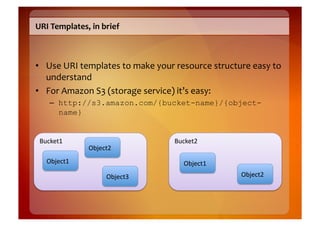
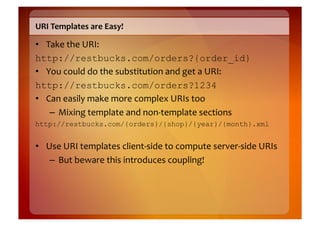


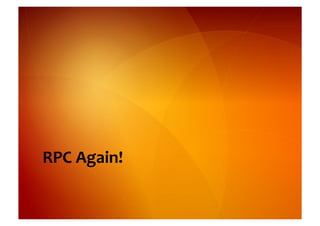




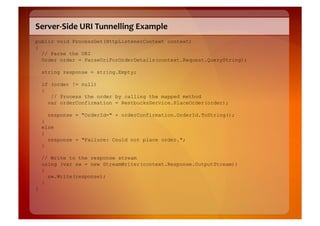







![.Net
POX
Service
Example
From
the
Web
server
private void ProcessRequest(HttpListenerContext context)
{
string verb = context.Request.HttpMethod.ToLower().Trim();
switch (verb)
{
case "post": Check
HTTP
Verb
(we
{ want
POST)
// Everything's done with post in this case
XmlDocument request = new XmlDocument();
request.Load(XmlReader.Create
(context.Request.InputStream));
Dispatch
it
for
processing
Turn
the
HTTP
body
into
an
XmlElement result = MyApp.Processdocument
for
XML
(request.DocumentElement); processing
byte[] returnValue =
Utils.ConvertUnicodeString
(Constants.Xml.XML_DECLARATION +
result.OuterXml);
Get
XML
result,
and
get
bytes
context.Response.OutputStream.Write(returnValue, 0,
returnValue.Length);
break;
} ... Return
XML
bytes
to
client](https://image.slidesharecdn.com/tutorial-091217045854-phpapp02/85/REST-in-Practice-45-320.jpg)

![C#
POX
Client
Example
public OrderConfirmation PlaceOrder(string customerId, Item[] items)
{
// Serialize our objects
XmlDocument requestXml = CreateXmlRequest(customerId, items);
var client = new WebClient();
var ms = new MemoryStream();
requestXml.Save(ms);
client.Headers.Add("Content-Type", "application/xml");
ms = new MemoryStream(client.UploadData("http://restbucks.com/
PlaceOrder", null, ms.ToArray()));
var responseXml = new XmlDocument();
responseXml.Load(ms);
return CreateOrderConfirmation(responseXml);
}](https://image.slidesharecdn.com/tutorial-091217045854-phpapp02/85/REST-in-Practice-47-320.jpg)
![Java
Apache
Commons
Client
public class OrderingClient { private String sendRequestPost(String
request, String uri)
private static final String XML_HEADING = "<?xml throws
version="1.0"?>n";
IOException, HttpException {
private static final String NO_RESPONSE =
"Error: No response."; PostMethod method = new PostMethod
(uri);
public String placeOrder(String customerId, method.setRequestHeader("Content-
String[] itemIds) type", "application/xml");
throws Exception {
method.setRequestBody(XML_HEADING +
request);
// XML string creation omitted for brevity
// ...
String responseBody = NO_RESPONSE;
try {
String response = sendRequestPost(request, new HttpClient().executeMethod
"http://restbucks.com/PlaceOrder"); (method);
responseBody = new String
Document xmlResponse = (method.getResponseBody(), "UTF-8");
DocumentBuilderFactory.newInstance()
.newDocumentBuilder } finally {
().parse( method.releaseConnection();
new InputSource(new }
StringReader(response)));
return responseBody;
// XML response handling omitted for brevity }
} }](https://image.slidesharecdn.com/tutorial-091217045854-phpapp02/85/REST-in-Practice-48-320.jpg)







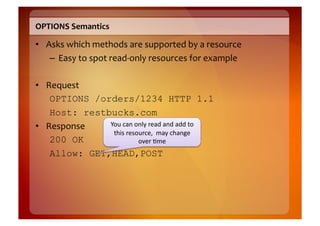


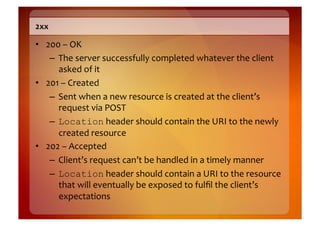















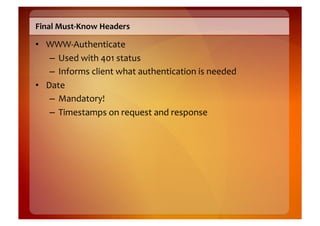











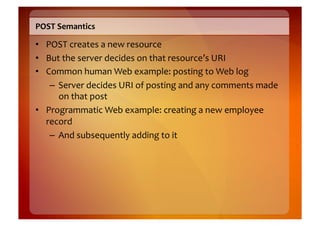



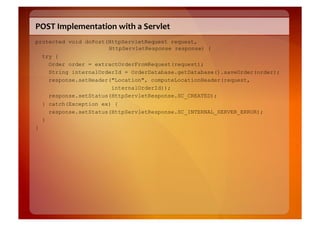

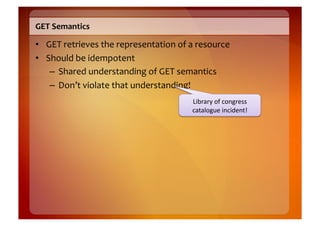

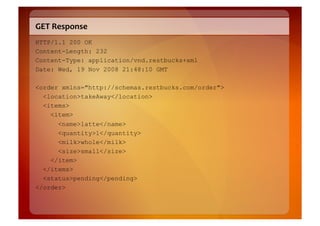


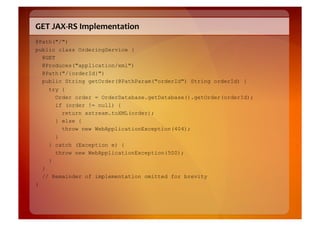





![WCF
Implementation
for
PUT
[ServiceContract]
public interface IOrderingService
{
[OperationContract]
[WebInvoke(Method = "PUT", UriTemplate = "/orders/
{orderId}")]
void UpdateOrder(string orderId, Order order);
// …
}](https://image.slidesharecdn.com/tutorial-091217045854-phpapp02/85/REST-in-Practice-104-320.jpg)
![WCF
Serializable
Types
[DataContract(Namespace = "http://schemas.restbucks.com/order", Name = "order")]
public class Order
{
[DataMember(Name = "location")]
public Location ConsumeLocation
{
get { return location; }
set { location = value; }
}
[DataMember(Name = "items")]
public List<Item> Items
{
get { return items; }
set { items = value; }
}
[DataMember(Name = "status")]
public Status OrderStatus
{
get { return status; }
set { status = value; }
}
// …
}](https://image.slidesharecdn.com/tutorial-091217045854-phpapp02/85/REST-in-Practice-105-320.jpg)













